Mating
Disruption for the Navel Orangeworm
The navel orangeworm (NOW), Amyelois transitella, has been
in the U.S. for 100 years. Initially, it was a pest of oranges,
then it developed a taste for almonds, walnuts and pistachios.
It is a key pest of these crops, causing at least $75 million
in damage each year. Larvae feed directly on the nutmeats,
contaminating them with frass, making them unmarketable.
NOW overwinters as larvae and pupae in unharvested nuts
(mummies). Climate change with warmer winters and early
springs have encouraged the pest. Because damaged nuts can
be contaminated with aflatoxins, processors demand almond
crops with less than 2% NOW damage. Draconian sanitation
measures are needed to meet the standard, and the low damage
thresholds have encouraged the development of NOW mating
disruption methods.
Orchards are saturated with the pheromone (11Z, 13Z)-hexadecadienal.
Commercial products include meso diffusion dispensers (Cidetrak®),
and aerosol cans (puffers) that periodically release the
pheromone (Checkmate®, Isomate®, Semios NOW Eco®).
Addition of mating disruption to a pest management program
can lead to damage reduction of up to 80%. In almonds, mating
disruption can in some cases replace some or all NOW insecticide
sprays, leading to good crop protection and good profits.
Insecticide reduction has positive environmental effects,
protecting workers from exposure and leading to fewer impacts
on beneficial insects. Mating disruption is especially useful
in organic production, helping growers meet the strict damage
thresholds required by processors.
This issue of the IPM Practitioner also includes Pesticides
and Soil, Forever Chemicals, IPM News, and ESA Conference
Notes.
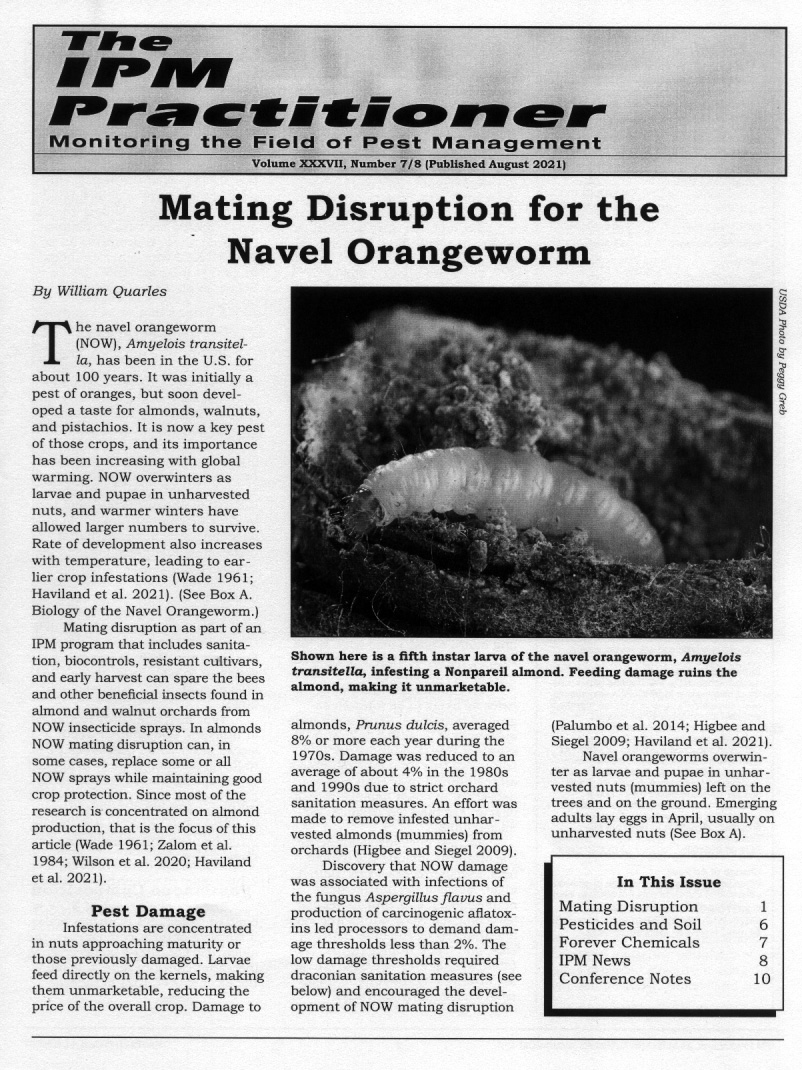
If you want to read this publication, please click here.
Hard copies are $8 each. California residents add 10.25%
sales tax. Quantity discounts are available until supplies
run out. BIRC is a non-profit that depends on the support
of the public. If you would like to make a tax-deductible
donation to help us continue our work, become a BIRC member,
or order a publication, use the BIRC order form here.
Previous
Posts:
Saving
the Monarchs
Over the past 20 years U.S. overwintering populations
of monarch butterflies, Danaus plexippus, have been steadily
declining. Since 1996, eastern populations overwintering
in Mexico have declined 80-84%. But western populations
that overwinter along the California coast have dropped
more than 99%. Western populations have plunged from about
four million in the 1980s to less than 2,000 in 2020. The
western migratory monarch is on the brink of extinction.
There are multiple causes, including habitat destruction,
loss of milkweed due to development and herbicides, nectar
plants poisoned with systemic pesticides such as neonicotinoids,
and drought associated with climate change. In the west,
wildfires are becoming more important. As the acres burned
in California increase, overwintering populations show a
corresponding decrease.
Monarchs are resilient, and survived the asteroid that killed
the dinosaurs 65 million years ago. But they may not recover
from the accumulated environmental insults of pesticides,
habitat destruction, and drought without our help. We should
not such a beautiful work of nature go extinct.
To save the monarchs, we should use fewer pesticides. We
should especially avoid systemics that could contaminate
nectar plants. IPM methods can be used to reduce pesticide
applications in agriculture. Monarchs depend solely on milkweed
for caterpillar development. Planting milkweed and nectar
plants in gardens can encourage them.
Saving the monarchs will require a concerted social effort.
Garden clubs can establish committees to focus action on
monarch conservation. Milkweed and nectar plants can be
planted on public land and along roadsides. Golf courses
can establish milkweed and nectar plants in areas away from
putting greens. Listing Danaus plexippus as an endangered
species might help.
In addition to these short term solutions, saving the monarchs
may require a long term commitment to greenhouse gas reduction.
Increased use of regenerative agriculture, conversion to
renewable energy sources, and reduction of fossil fuel consumption
could help reduce drought, fires, and extreme weather conditions
associated with climate change.
By making things better for the monarchs, we will also be
making things better for ourselves.
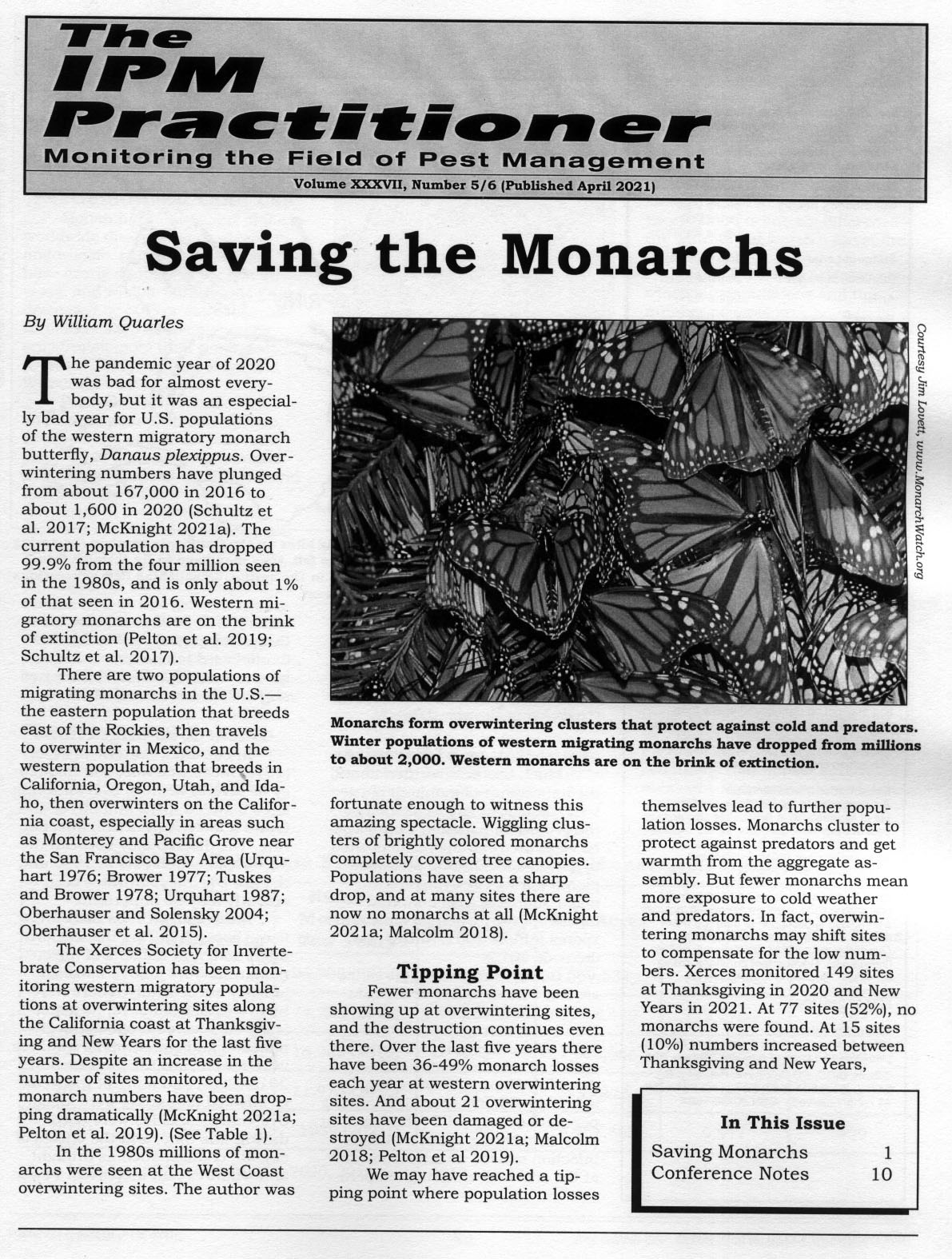
If
you want to read this publication, please click here.
Hard copies are $8 each, including postage. California residents
add 9% tax. Quantity discounts are available until supplies
run out. BIRC is a non-profit that depends on the support
of the public. If you would like to make a tax-deductible
donation to help us continue our work, become a BIRC member,
or order a publication, use the BIRC order form here.
Pest of Indoor Plants
Indoor plants range from African violets above
the kitchen sink to thousands of plants in large greenhouse
operations. The latest issue of Common Sense Pest Control
Quarterly provides effective, least-toxic solutions
for the pests of indoor plants. Many of these pests are
insects or mites that suck nutrients, weakening, disfiguring,
or even killing plants. These plant vampires include aphids,
mealybugs, scales, mites, thrips, and whiteflies.
Since these houseplant pests have similar lifestyles, they
respond to similar management plans. Proper attention to
monitoring, cultural, physical, biological and least-toxic
chemical controls can keep plants healthy. This integrated
approach can also be used to protect outdoor gardens.
Houseplant pests respond to cultural controls and least-toxic
pesticides. Greenhouses often add biological controls to
these components. This issue of the Quarterly evaluates
least-toxic pesticides such as soaps, oils and biopesticides
and lists possible suppliers.
Because land is becoming more expensive, greenhouses will
become more important in the future for production of food,
ornamentals, and exotic items such as Cannabis sativa.
Production of hemp is now legal in the U.S. Medical marijuana
is legal in 35 states and recreational marijuana in 15 states.
Mites are major pests of indoor Cannabis, and the
article "Managing Mites on Cannabis"
provides solutions such as biocontrols and biopesticides
that do not leave toxic residues.
Another major pest of indoor plants is fungus gnats. Whether
the problem is seen in a few houseplants or in a large greenhouse
operation, the latest Quarterly provides effective solutions
without resorting to broadspectrum pesticides.
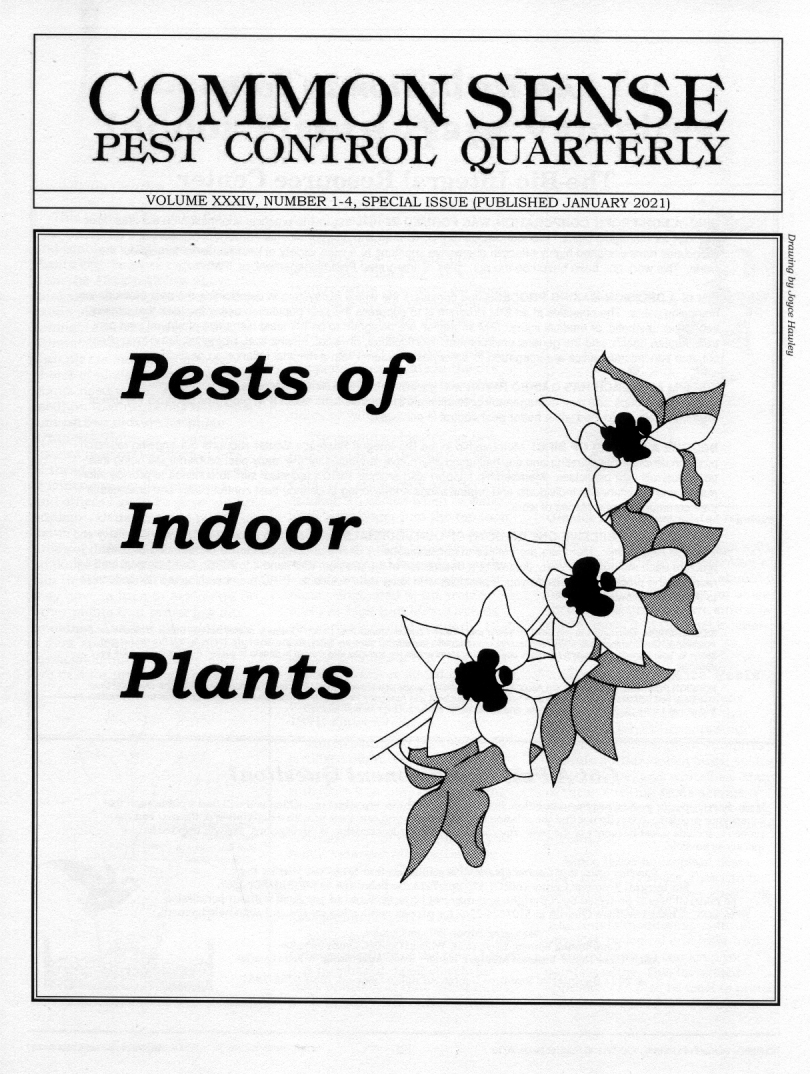
If
you want to read this publication, please click here.
Hard copies are $8 each, including postage. California residents
add 9% tax. Quantity discounts are available until supplies
run out. BIRC is a non-profit that depends on the support
of the public. If you would like to make a tax-deductible
donation to help us continue our work, become a BIRC member,
or order a publication, use the BIRC order form here.
Special Pheromone Issue
The latest IPM Practitioner is a Special Pheromone
Issue containing three articles and a Special Pheromone
Report from the 2019 ESA Conference in St. Louis, MO. The
first article is “Pheromones and Attractants for Invasive
Pests.” The U.S. is being overrun by invasive pests.
A partial list is the brown marmorated stink bug, Halyomorpha
halys; the spotted lanternfly, Lycorma delicatula; spotted
wing drosophila, Drosophila suzukii; and the emerald ash
borer, Agrilus planipennis.
Management is either frequent pesticide sprays or a patchwork
quilt of IPM methods. Pheromones and attractants are the
key to IPM management and can lead to a reduction in pesticide
use. This article reviews the pheromone and attractant technology
necessary to manage these pests.
A Cure for Huanglongbing?
Huanglongbing or yellow dragon is one of the most serious
citrus diseases worldwide. It is caused by a bacterium that
produces yellow foliage and small, green, misshapen fruit
with bitter juice. Within 3-5 years infected trees start
to die, and up to now there is no cure.
Now, a cure may have been found. An antimicrobial peptide
produced by Australian finger limes, Citrus australasica,
can kill the microbe. The peptide also moves systemically
when sprayed on citrus, producing induced immunity that
protects treated citrus from infection.
Pyrethroids and Poverty
A landmark epidemiological study has shown that people with
the highest levels of pyrethroid exposure are three times
more likely to die of cardiovascular disease than those
with lower exposure. This group is also 1.56 times more
likely to die of any cause than those with low exposures.
Either pyrethroids are more toxic than we thought, or there
is a confounding factor such as poverty which is contributing
to the excess mortality. People who live in substandard
housing, with poor access to medical care, and exposed to
unhealthy air pollution levels may be more likely to show
adverse health effects. These same people are often exposed
to pyrethroids that treat infestations of cockroaches, ants,
and bed bugs.
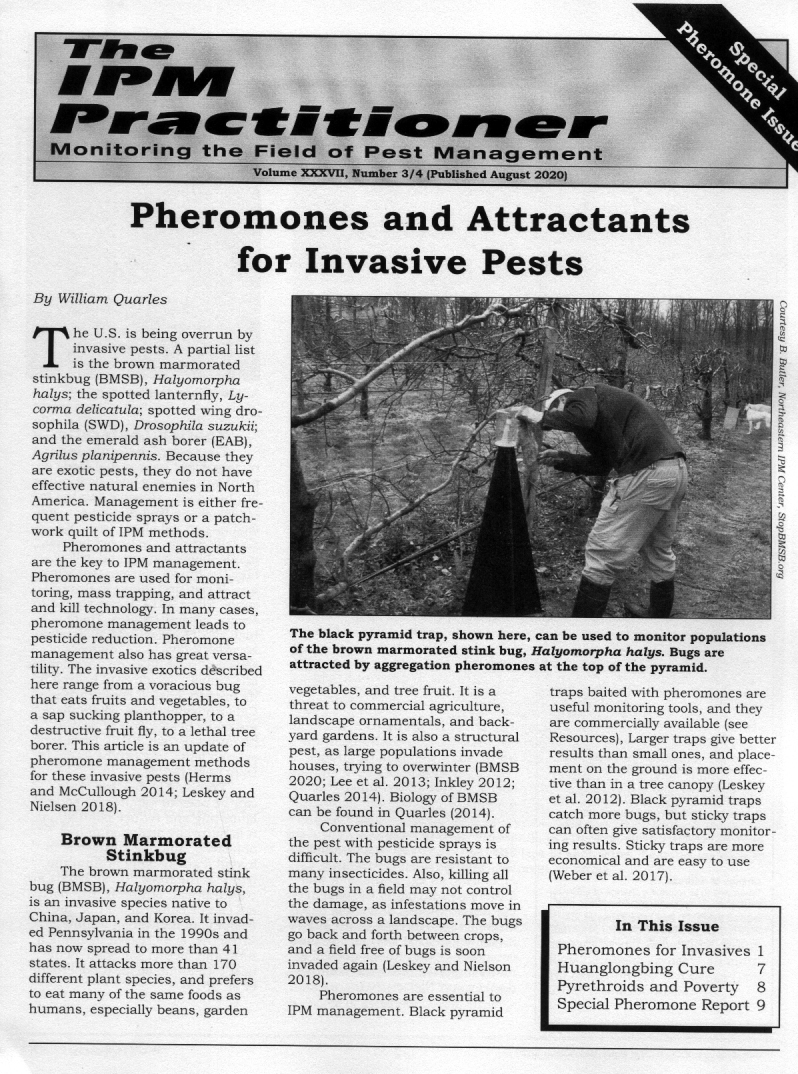
If you want to read this publication, please click here.
Hard copies are $8 each, including postage. California residents
add 9% tax. Quantity discounts are available until supplies
run out. BIRC is a non-profit that depends on the support
of the public. If you would like to make a tax-deductible
donation to help us continue our work, become a BIRC member,
or order a publication, use the BIRC order form here.
Coronavirus
and Ecology
The same ecological disturbances that have devastated
populations of wild vertebrates, monarch butterflies, bees
and other beneficial insects have contributed to the emergence
of the coronavirus disease COVID-19. Increasing human population
has led to encroachment on wildlife areas and closer contact
with animals carrying viruses and other pathogens that are
able to infect humans.
Since 1980, the human population has nearly doubled, and
new human pathogens have been discovered at the average
rate of about three per year. Increased development is destroying
wildlife habitat, pushing humans into contact with wild
animals. There are also many direct interactions of humans
with wild animals through hunting and wildlife trade.
The novel coronavirus that has caused the current worldwide
pandemic likely originated in the horseshoe bat, Rhinolophus
affinis. This bat roosts in remote Chinese mountain caves
near Yunnan, and is used in traditional Chinese medicine.
Bat traders likely caught infected bats and brought them
to the Huanan wholesale market in Wuhan.
The horseshoe bat virus RaTG13 is 96.3% genetically identical
to the coronavirus SARS-CoV-2 that has caused the worldwide
pandemic. Mutation and recombination of RaTG13 likely led
to the emergence of SARS-CoV-2. Humans were either infected
directly by the bats, or the bats infected another animal
that then infected humans. The virus is extremely infectious,
and 43 people in Wuhan have now infected the whole world.
The virus spreads mainly through aerosols, and COVID-19
cases increase exponentially. About 80% of the people infected
have no symptoms, but carry the disease to others. About
20% of the infections are serious, and require hospitalization.
Of those hospitalized, at least 15% will likely die. Cases
serious enough to be confirmed by testing may eventually
lead to a death rate of about 10%.
The best defense is good nutrition, as Chinese clinical
studies show that serious cases on ventilators have lower
hemoglobin levels than those in the general hospital population.
Hemoglobin in red blood cells carry oxygen that help with
survival from COVID-19 pneumonia.
SARS-CoV-2 is the second in a series of SARS related bat
coronaviruses. The first caused SARS. The second caused
COVID-19. There are a cluster of these viruses poised for
emergence into the human population.
Americans can no longer ignore obscure diseases in remote
areas of the world. We should invest more resources in worldwide
pathogen surveillance that will prepare us for future pandemics.
Cooperation, not isolation, is the way toward survival.
We should also try to mitigate some of the ecological damage
that led to the outbreak. Regulation of worldwide trade
in wild animals would be a good start.
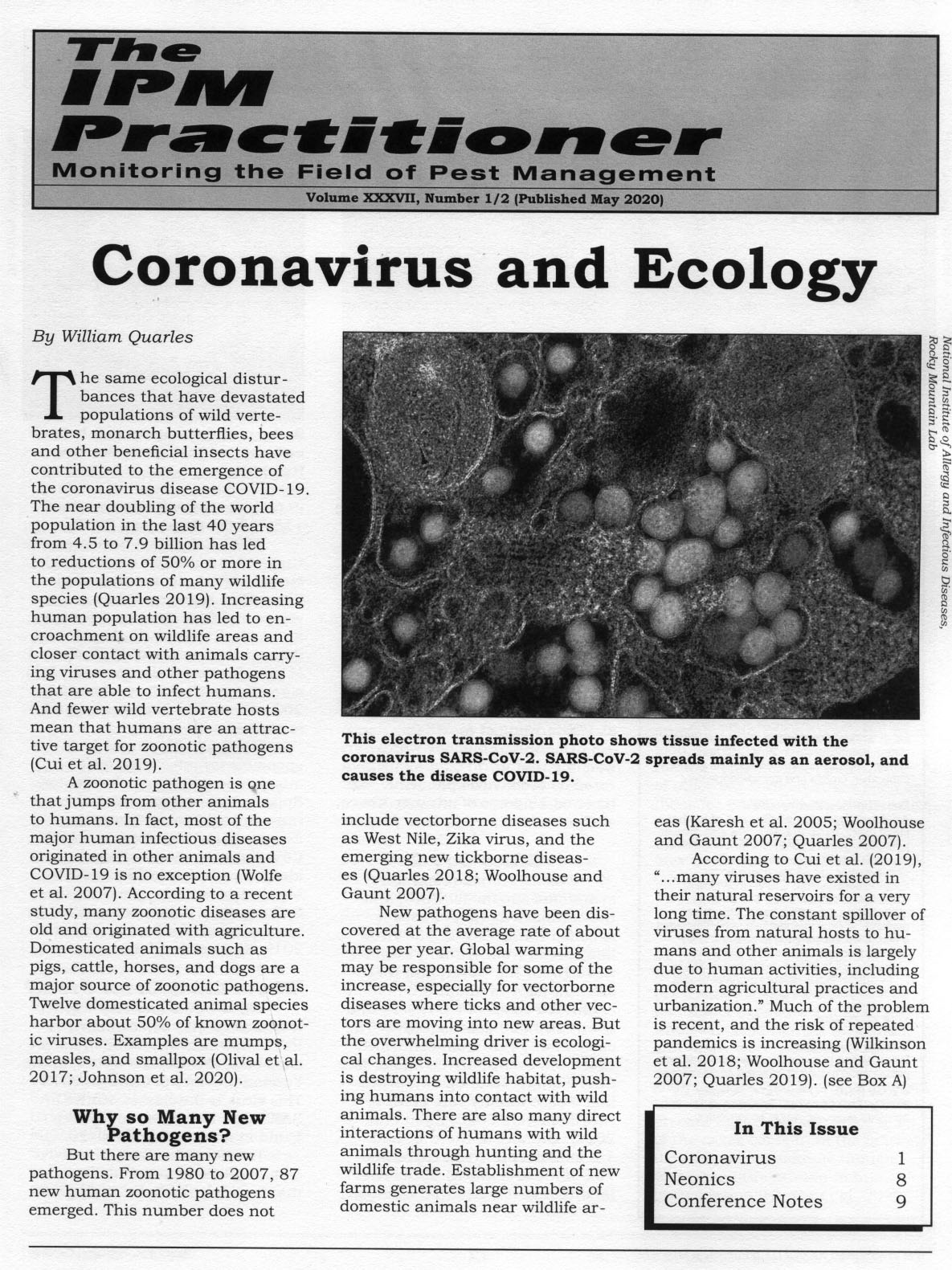
If
you want to read this publication, please click here.
Hard copies are $8 each, including postage. California residents
add 9% tax. Quantity discounts are available until supplies
run out. BIRC is a non-profit that depends on the support
of the public. If you would like to make a tax-deductible
donation to help us continue our work, become a BIRC member,
or order a publication, use the BIRC order form here.
Least-Toxic and Non-Toxic Fungicides
Global warming has led to major problems with fungi.
Human deaths each year from Aspergillus, Cryptosporidium
and Candida now exceed combined deaths from malaria and
tuberculosis. And fungi are killing millions of bats and
amphibians.
Plants are also at risk. Fungi have attacked agricultural
row crops, orchards, and backyard rose gardens. Increasing
plant disease has led to large fungicide increases. For
example, combined fungicide applications to U.S. corn, soybeans
and wheat increased 10-15 fold from 2004 to 2009.
Fungicides are also causing environmental contamination
and increased toxic exposure. Streams are contaminated with
fungicides that are potentially carcinogenic or have other
health effects. Environmentally relevant concentrations
of fungicides are killing amphibians and may be contributing
to honey bee and pollinator declines.
And overuse of fungicides is causing pest resistance. Many
fungicides are specific in action and can be neutralized
by simple DNA point mutations in pathogen populations. The
result is increased disease with fewer effective fungicides.
There is thus a great need for fungicides with low toxicity
that are less likely to cause pathogen resistance. This
issue of Common Sense Pest Control Quarterly reviews least-toxic
and non-toxic fungicides. Many of them have general modes
of action such as desiccation, induced systemic resistance,
or pH changes that are less likely to cause resistance.
Backyard and greenhouse rose gardens were used as the model
crop. But least-toxic fungicides for roses can also be used
on strawberries, cucumbers, tomatoes, Cannabis sativa and
other high value crops.
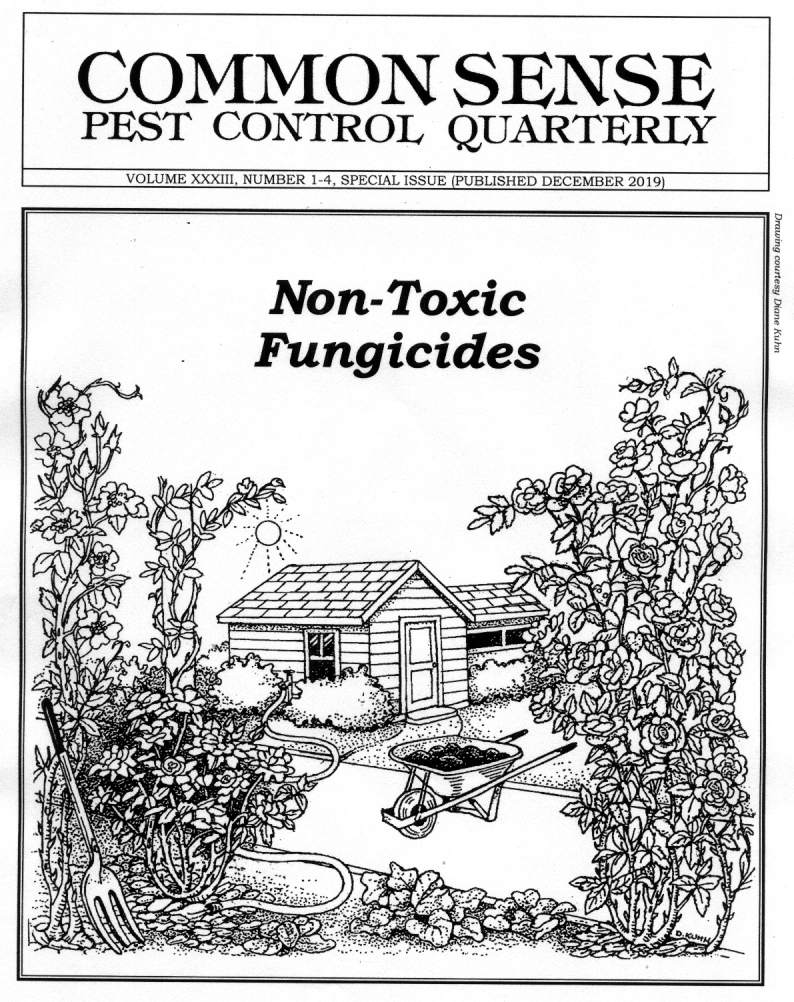
If you want to read this publication, please click
here. Hard copies are
$8 each, including postage. California residents add 9%
tax. Quantity discounts are available until supplies run
out. BIRC is a non-profit that depends on the support of
the public. If you would like to make a tax-deductible donation
to help us continue our work, become a BIRC member, or order
a publication, use the BIRC order form here.
Neonic Seeds are Not Needed
Neonicotinoids are the most widely used insecticides
in the world. They are found in field crops, orchards, parks,
landscapes, backyard gardens, on ornamentals, lawns, pets,
and in structural pest control.
Neonics can kill pollinators and biological controls. They
are water soluble and persistent, polluting water, including
drinking water. They can kill aquatic invertebrates, and
have been implicated in insect decline, leading to reduced
populations of birds, bats, and frogs.
Seed treatments are especially objectionable because they
are often not needed. They do not consistently increase
yields in soybeans, corn, sunflowers, sugar beets, and cotton.
There is some evidence for yield increases in wheat and
rice when pest challenges are high. For sporadic early season
pests in some crops, they can be effective, but IPM methods
provide similar protection. Neonic seeds have been banned
in European field crops, and yields have not been affected.
Since benefits are not outstanding, and destructive effects
on wildlife are widespread, neonic seed treatments, especially
in corn and soybeans, should be reduced or banned.
Is Agriculture Killing Whales?
This publication also discusses fertilizer pollution. Application
of synthetic fertilizers is excessive and increasing. This
year more than 400 million pounds of U.S. fertilizer will
end up in the oceans. Nutrients are causing algae blooms
larger than the size of Massachusetts in the Gulf of Mexico.
Nutrients and warming oceans cause algae to increase production
of neurotoxins such as saxitoxin and domoic acid. These
toxins are concentrated by shellfish, anchovies, herring
and other sea creatures. When whales feed on contaminated
prey, they can be exposed to domoic acid, leading to loss
of short term and spatial memory. This exposure may be causing
the increased number of Òunusual mortality eventsÓ
seen for whales this year.
Other articles in this issue include Trump’s War on
Pollinators, and Highlights of the 2018 ESA meeting Vancouver.
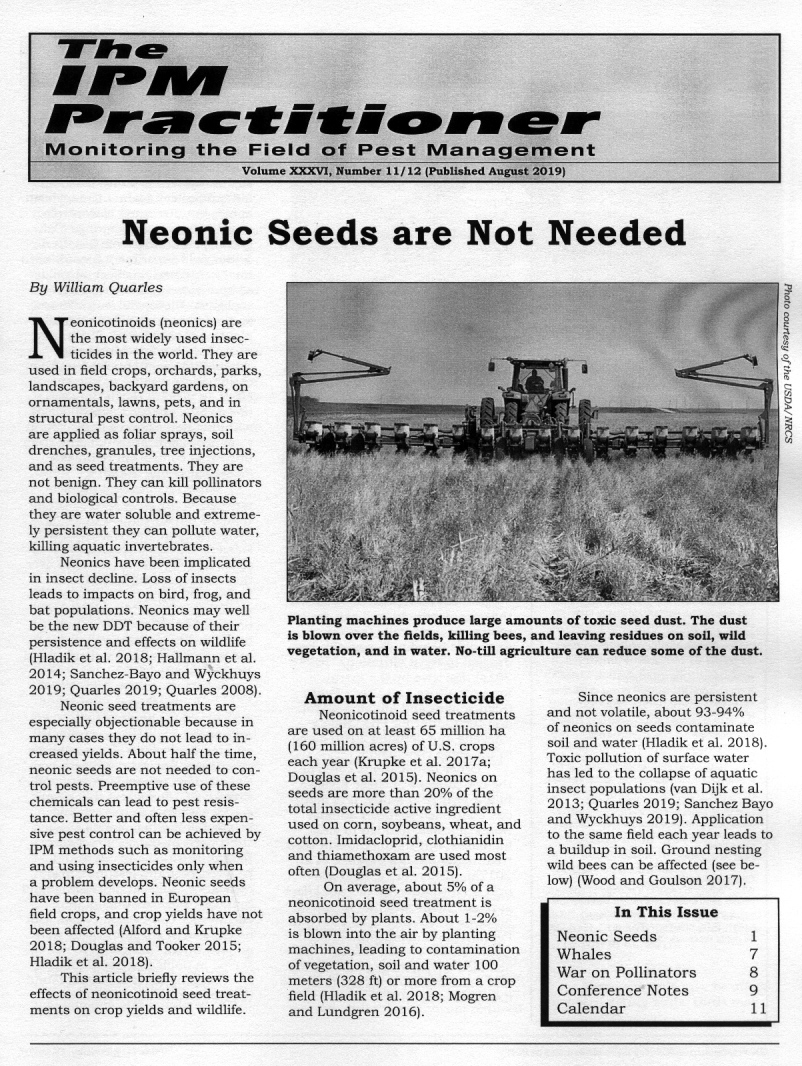
If you want to read this publication, please click here.
Hard copies are $8 each, including postage. California residents
add 9% tax. Quantity discounts are available until supplies
run out. BIRC is a non-profit that depends on the support
of the public. If you would like to make a tax-deductible
donation to help us continue our work, become a BIRC member,
or order a publication, use the BIRC order form here.
IPM for the Western Bean Cutworm
Western bean cutworm (WBC), Striacosta albicosta,
is a pest created by modern agriculture, as monocultures,
genetically engineered crops, and climate change encourage
it. Introduction of genetically engineered corn in 1996
led to an explosive range expansion. It spread throughout
the Midwest corn belt and into corn producing areas of eastern
states in a period of just 10 years.
WBC is a late season pest, and larvae eat corn kernels and
damage bean pods. Field damage of 30-40% has been seen.
Average infestations of one larva per plant in corn leads
to yield reductions of 3.7 to 15 bushels per acre.
Conventional pest management includes genetically engineered
BT corn, neonicotinoid seed treatments, and pyrethroid insecticide
sprays. But WBC is resistant to BT, and is becoming resistant
to pyrethroids. Neonicotinoid seed treatments are not effective
for late season pests, and make the problem worse by killing
biocontrols.
IPM for the western bean cutworm consists of monitoring
with pheromone traps, scouting fields for egg masses and
damage, cultural controls, conservation biocontrol, releases
of parasitoids and nematodes, host resistance, and application
of least-toxic pesticides as a last resort.
IPM management can reduce or eliminate pesticide applications.
New technology such as automated pheromone traps connected
to the internet make real-time monitoring of areawide populations
possible.
This publication is a special pheromone issue of the IPM
Practitioner. It includes a Special Pheromone Report from
the 2018 ESA meeting in Vancouver.
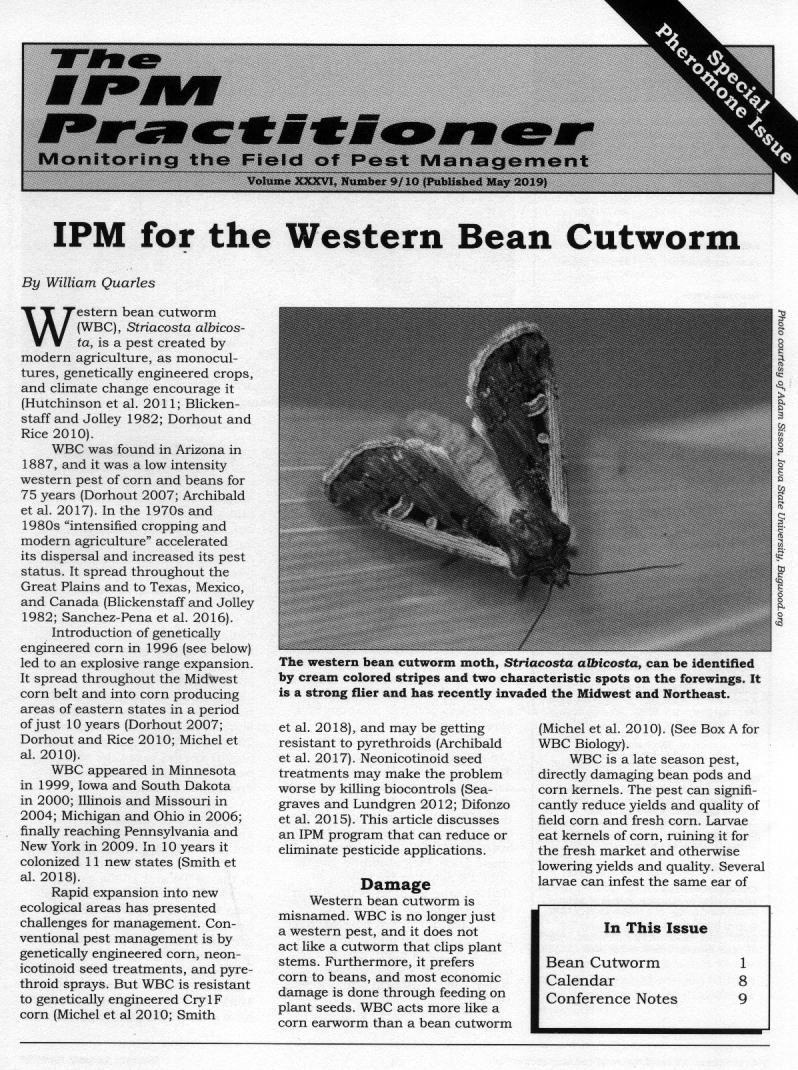
If you want to read this publication, please click here.
Hard copies are $8 each, including postage. California residents
add 9% tax. Quantity discounts are available until supplies
run out. BIRC is a non-profit that depends on the support
of the public. If you would like to make a tax-deductible
donation to help us continue our work, become a BIRC member,
or order a publication, use the BIRC order form here
Racing Towards Silent Spring
In the last 40 years, the human population has nearly doubled,
but human activity has caused catastrophic decline in other
species.
Butterfly, bee, and beetle populations have seen reductions
of 50% or more. Birds, bats and frogs that depend on insects
for food are showing population reductions of 28-58%. Major
drivers of the catastrophic collapse are habitat destruction,
agricultural intensification, pesticide use, and climate
change.
One study shows that numbers of freshwater vertebrates such
as fish and frogs have dropped by more than 80%. Declines
are being driven by water pollution, pesticides, and destruction
of aquatic insects.
The degradation of wild populations was not necessary. We
should try to mitigate some of this damage, or there will
be consequences such as loss of pollinators, loss of aquatic
food, and a highly restricted food supply.
This publication briefly reviews insect decline and makes
suggestions to mitigate the damage. For example, we should
increase regenerative and organic agriculture. Away from
crop areas, farmscaping can be used to increase resources
for beneficial insects. IPM should be used to control pests.
Backyard gardens and roadside plantings can compensate for
some of the habitat loss.
Life on earth is being reconfigured from diverse populations
in ecological balance to a simplified ecosystem of humans,
human food, and human pests. Unless we reverse the wholesale
destruction of wildlife, reduce pesticide applications,
and mitigate global warming, we are headed toward the Silent
Spring pictured by Rachel Carson.
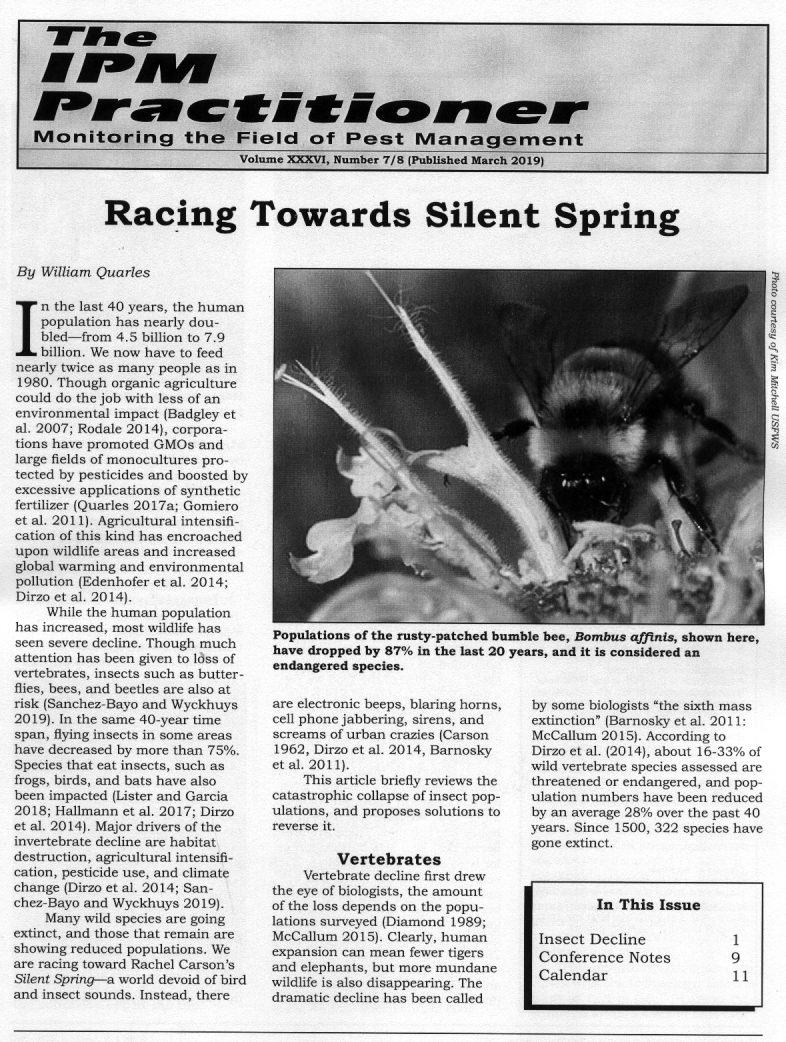
If you want to read this publication, please click here.
Hard copies are $8 each, including postage. California residents
add 9% tax. Quantity discounts are available until supplies
run out. BIRC is a non-profit that depends on the support
of the public. If you would like to make a tax-deductible
donation to help us continue our work, become a BIRC member,
or order a publication, use the BIRC order form here.
Alternatives
to Glyphosate
About 280 million pounds of the herbicide glyphosate are
applied each year. There is widespread contamination of
breakfast cereal, wine, and other commodities. Glyphosate
has been found in 93% of people tested in the U.S.
According to the International Agency for Research on Cancer
(IARC), glyphosate is a probable human carcinogen. Thousands
of lawsuits have been filed against Monsanto and Bayer.
Applicators are most at risk, and a jury trial in California
resulted in a $289 million dollar award to a landscape professional
dying of non-Hodgkins lymphoma.
Glyphosate alternatives are needed in GMO crops because
of weed resistance. Alternatives are also needed for roadside
weed control, for municipal landscapes, for golf courses,
playing fields, and weed control in homes and gardens. Cities
are concerned about potential liability and are actively
seeking alternatives.
IPM methods can provide a comprehensive solution to weed
management. These include weed mapping, cultural controls,
mulching, microbials, mechanical controls, steaming, flaming,
solarization, allelopathy, and application of least-toxic
herbicides. This issue includes a review of IPM weed management
methods and an update on the efficacy of least-toxic herbicides.

If you want to read this publication, please click here.
Hard copies are $8 each, including postage. California residents
add 9% tax. Quantity discounts are available until supplies
run out. BIRC is a non-profit that depends on the support
of the public. If you would like to make a tax-deductible
donation to help us continue our work, become a BIRC member,
or order a publication, use the BIRC order form here.
IPM
for Cannabis Pests
About 35 million people in the U.S. use marijuana on a regular
basis. It is the fourth most popular recreational drug after
caffeine, alcohol, and tobacco. Marijuana is legal for medical
use in 31 states, and it has been decriminalized in 13 other
states. Recreational marijuana is legal for adults in nine
states. But Cannabis is still illegal under federal law.
Marijuana is the largest cash crop in the U.S. with an estimated
value of $35.8 billion each year. Nearly $700 million in
imported hemp products are sold in the U.S. each year. Hemp
has been grown for thousands of years. It is a renewable
source of fibers for ropes, bags, paper, building materials,
and other products. In blighted rural areas where coal mine
and tobacco jobs have been lost, hemp could provide economic
revitalization. A federal law legalizing hemp production
was introduced this year.
Because federal law prohibits Cannabis production, there
is a pest management problem in the states where it is legal.
The EPA will not register a pesticide with marijuana or
Cannabis listed on the label. Thus, most EPA registered
pesticides cannot be applied. Yet many states allow marijuana
to be grown, sold, and consumed. To make the best of a bad
situation, cooperation between state and federal agencies
has led to lists of approved pesticides, mostly soaps, oils,
and biopesticides.
Because pesticides allowed are somewhat limited, the situation
provides an ideal opportunity for IPM methods. IPM management
should result in less environmental pollution, fewer pesticide
exposures, and less pesticide contamination of the product.
Less pesticide contamination is important because the California
law requires that commercial marijuana be tested for pesticide
residues.
Nearly 300 insect pests have been associated with Cannabis.
Flower and leaf pests outdoors are hemp borers, budworms,
leafminers, and green stink bugs. Stalks and stems are attacked
by borers and beetle grubs. Frequent and sometimes serious
pests include aphids, whiteflies, mealybugs, mites, and
chewing bugs. Among the worst pests are hemp borers, budworms,
aphids, and mites. IPM methods include biological controls,
least-toxic pesticides, and cultural methods.
Illegal Cannabis operations outside are often marked by
pesticide and fertilizer pollution. State licensed legally
grown Cannabis provides an opportunity to reduce environmental
pollution. Because it is still illegal under federal law,
USDA organically certified Cannabis cannot be produced.
But an Eco or IPM label for Cannabis grown with organic
methods and low environmental impact is possible.
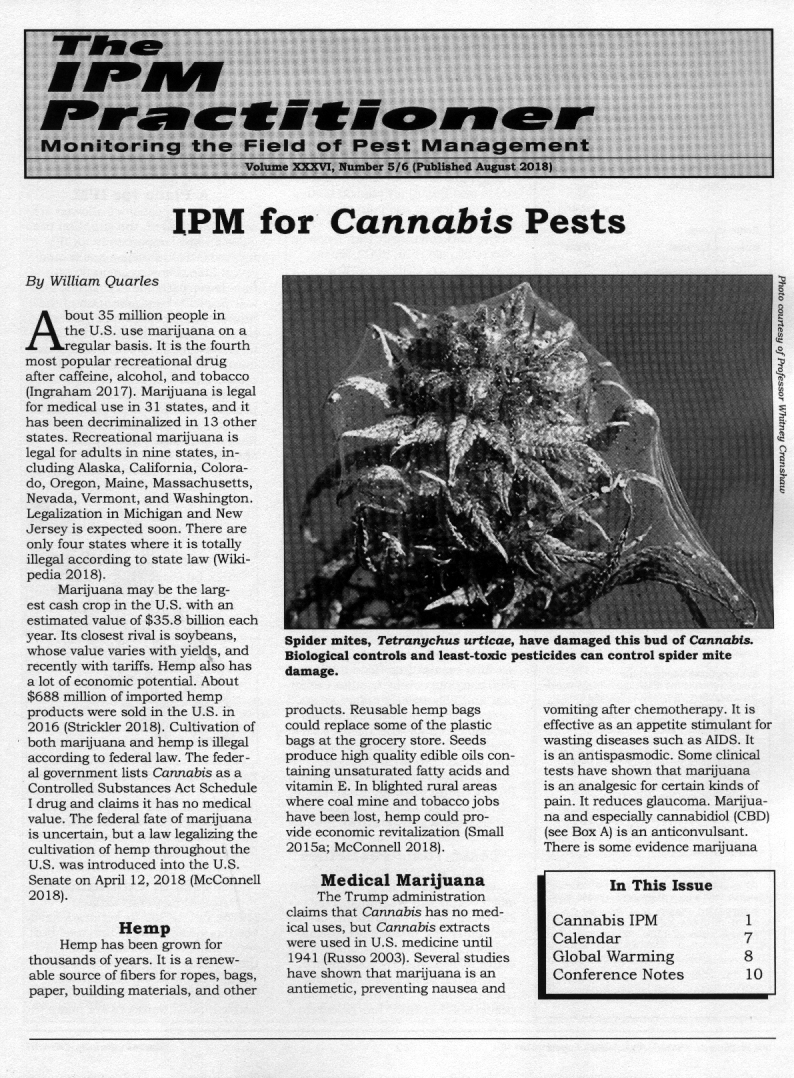
Also in this issue is the article Global Warming and Water
Pollution and highlights of the 2017 ESA Meeting in Denver,
CO.
If you want to read this publication, please click here.
Hard copies are $8 each, including postage. California residents
add 9% tax. Quantity discounts are available until supplies
run out. BIRC is a non-profit that depends on the support
of the public. If you would like to make a tax-deductible
donation to help us continue our work, become a BIRC member,
or order a publication, use the BIRC order form here.
Bringing
Back the Monarchs, Birds, and Bees
The monarch butterfly, Danaus plexippus, is one of the best
known environmental icons. But the migrating monarch is
in trouble. Over the last 20 years, overwintering populations
have dropped by 90%. Glyphosate applications to GMO crops
in the Midwest have killed the milkweed it needs to survive.
Other causes are herbicide applications to roadsides, overuse
of insecticides, destruction of flowering plants and nectar,
and extreme weather conditions caused by global warming.
This Quarterly reviews monarch biology, and outlines a strategy
that will result in Bringing Back the Monarchs. The strategy
includes establishing milkweed and nectar plants, converting
lawns to Monarch Way Stations by sheet mulching, planting
milkweed along highways, and raising awareness of laws designed
to help the monarchs. Lists of the best milkweed and nectar
plants are provided.
Monarch butterflies have survived the dinosaurs and have
probably been migrating for one million years. We should
not let pesticide pollution and human activity destroy them.
Working together, we can bring back the monarchs.
Not just monarchs, but bees and birds are also threatened.
Honey bee colony losses are currently about 44% a year,
and wild bees have also been impacted. Many bird species
are in decline, both rare species and common ones. The Audubon
Society has found that the 10 most common bird species have
seen a 70% decline.
Causes for the decline are similar: pesticide pollution,
development, and loss of habitat. Bees can be encouraged
by providing nesting sites and floral resources. Birds will
respond to plantings that provide seeds and nectar. Lists
of flowering plants that will encourage birds and bees are
provided.
Overall, this issue provides a pathway to a balanced garden
with increased pollination, increased biocontrol, and enhanced
habitat for birds, bees, and monarchs.
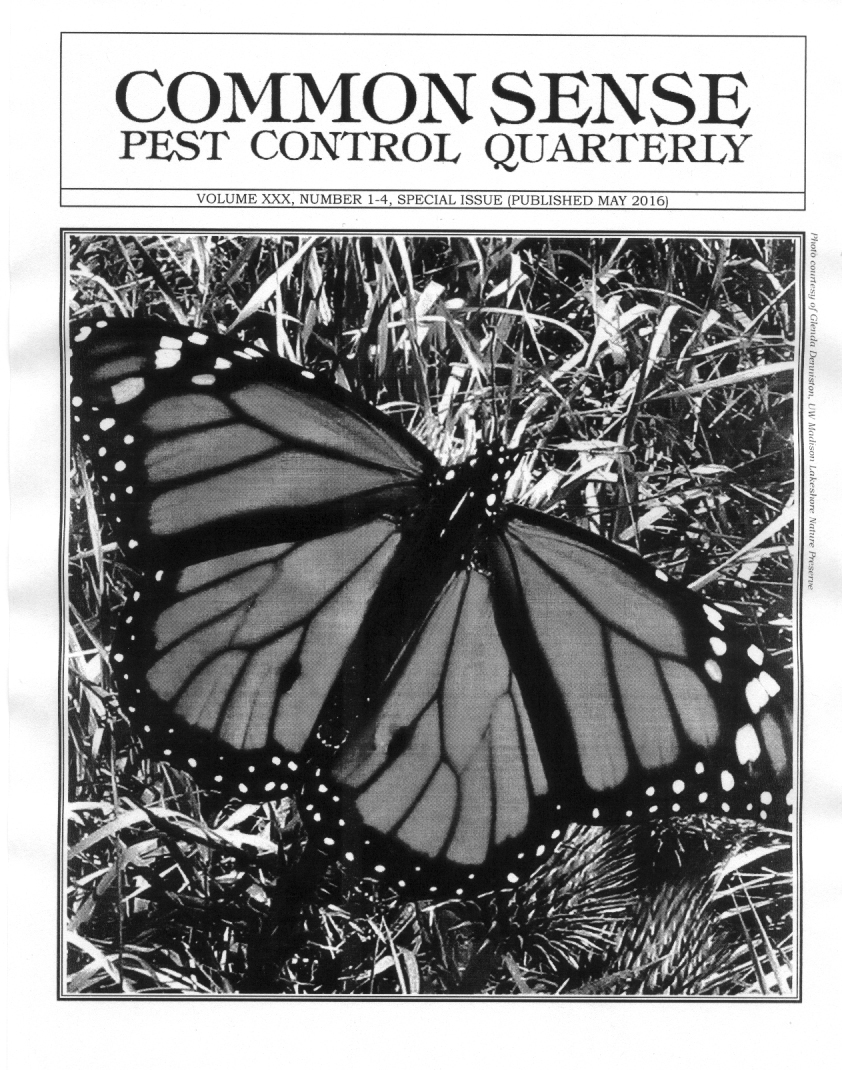
If
you want to read this publication, please click here.
Hard copies are $8 each, including postage. California residents
add 9% tax. Quantity discounts are available until supplies
run out. BIRC is a non-profit that depends on the support
of the public. If you would like to make a tax-deductible
donation to help us continue our work, become a BIRC member,
or order a publication, use the BIRC order form here.
Genetic
Engineering and Pest Control
The lead article in our latest issue, is Genetic Engineering
and Pest Control. About 20 years ago, the first transgenic
crops engineered for pest control were commercialized. These
transgenic crops have been controversial, and about 90%
of the U.S. population would like to see these crops labeled
as Genetically Modified Organisms (GMOs).
These crops have led to unexpected problems, such as destruction
of monarch butterfly habitat, contamination of soil and
water with pesticides, reduction of amphibian populations,
and in some cases increased soil pathogens.
Another consequence is systemic exposure to glyphosate,
neonicotinoid, and Bacillus thuringiensis pesticides in
our food supply. There are questions about safety that have
not been fully answered with rat toxicology experiments.
Overuse of these crops has led to resistant insects, resistant
weeds and other problems. To fix the problems that genetic
engineering has caused, new crops have been created that
will lead to increased pesticide use, and again to loss
of efficacy—truly a genetic treadmill.
Insects are also being engineered for pest control applications.
Releases planned are either self limiting or sustaining.
Self limiting transgenics will die out after a few generations.
Sustaining releases will use CRISPR gene drives to transform
or eliminate entire species. An example is the Aedes aegypti
mosquito.
GE crops brought unexpected problems, and engineered insects
represent an escalation of risks. Engineered insects also
pose ethical questions. Should we transform or eliminate
a wild species just to solve a pest or pesticide problem?
Should corporations be allowed to produce the corporate
bee, a transgenic resistant to neonicotinoids and other
proprietary pesticides?
Mass releases of transgenic organisms to solve a pest or
pesticide problem is a subject too important to be left
to corporations and regulators. Transformation or elimination
of a wild species should be a topic debated by the entire
society. Once the transgene genie is released, it may be
impossible to put it back into the bottle.
This issue also contains an update on Zika Virus and Birth
Defects. About 11,000 women who gave birth in Brazil in
2015 were likely infected with Zika. About 4,000 babies
were born with birth defects. Zika may be interacting with
agrochemicals or other factors to cause the problem.
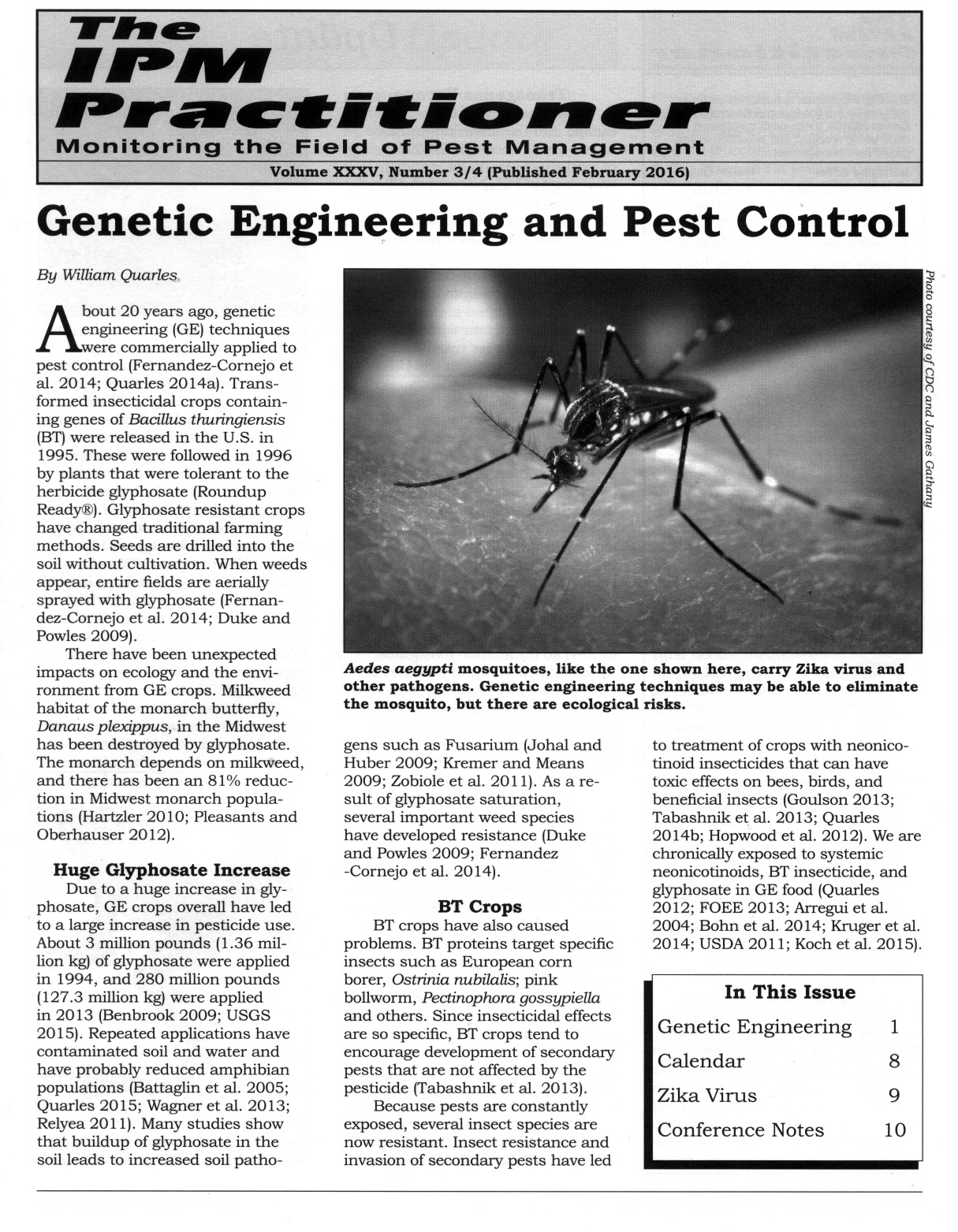
If you want to read this publication, please click here.
Hard copies are $8 each, including postage. California residents
add 9% tax. Quantity discounts are available until supplies
run out. BIRC is a non-profit that depends on the support
of the public. If you would like to make a tax-deductible
donation to help us continue our work, become a BIRC member,
or order a publication, use the BIRC order form here.
IPM for Spotted Wing Drosophila
Spotted wing drosophila, Drosophila suzukii, is a tiny fruit
fly causing big trouble. Its quick reproduction time, lack
of competition or natural enemies, increased survival due
to global warming, and dispersal in infested fruit shipments
has allowed it to spread with astonishing speed. In five
years, this invasive insect has spread completely through
the U.S. It is now an established pest in many fruit production
areas.
It lays its eggs in ripe fruit just before harvest, targeting
raspberries, blackberries, blueberries, strawberries, stone
fruit such as cherries and peaches, and even grapes and
figs. Fruit full of maggots cannot be sold, and 20% crop
loss is typical. Economic damage in just California, Oregon,
and Washington can be $500 million each year.
The pest attacks both commercial crops and backyard fruit.
It has a wide host range, switching to an alternate host
when preferred food is not available. When it overwinters,
it may choose non-host plants for shelter.
This article outlines an IPM approach that can manage the
pest, while sparing bees and beneficial insects. IPM methods
include monitoring, early cultivars, sanitation, mass trapping,
repellents, netting, biological controls, and biopesticide
sprays.
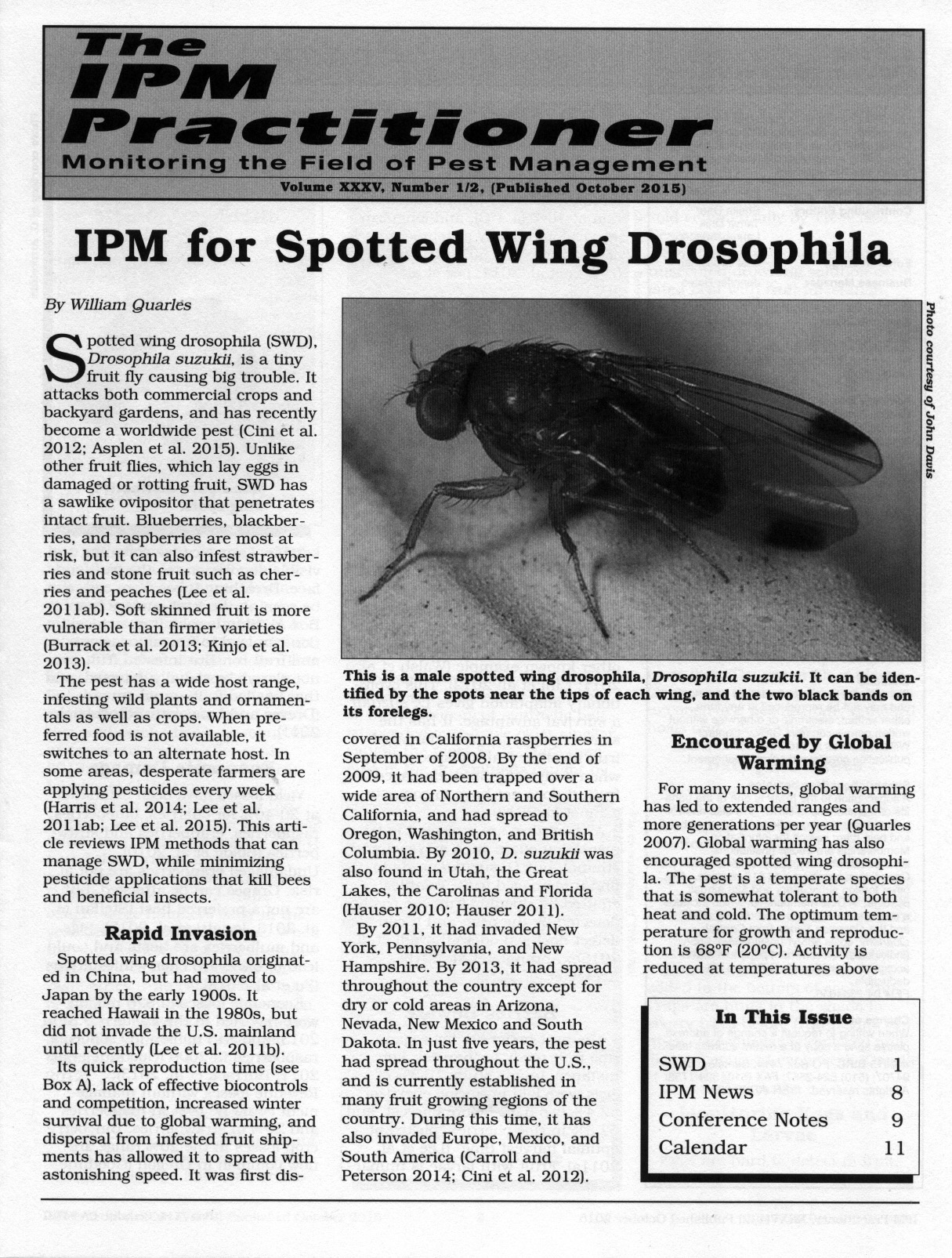
If you
want to read this publication, please click here.
Hard copies are $8 each, including postage. California residents
add 9% tax. Quantity discounts are available until supplies
run out. BIRC is a non-profit that depends on the support
of the public. If you would like to make a tax-deductible
donation to help us continue our work, become a BIRC member,
or order a publication, use the BIRC order form here.
The IPM Practitioner’s 2015 Directory of Least-Toxic
Pest Control Products
The IPM Practitioner’s 2015 Directory of Least-Toxic
Pest Control Products contains more than 2000 products produced
by more than 600 suppliers. The Directory is unique because
it is compiled by IPM technical experts, includes specific
product descriptions, and is organized in concert with the
IPM decision making process. Thus, it is easy to find a
biological control for an aphid, a pheromone for a moth,
or a bait for an ant. The Directory gives contact information
and access to suppliers of biocontrol products, traps, pheromones,
physical controls, tools, barriers, and least-toxic chemical
control products. The Directory is a valuable asset for
anyone trying to practice IPM and reduce pesticide exposures.
Products listed are useful for structural pest control,
greenhouse production, home gardening, and organic farming.
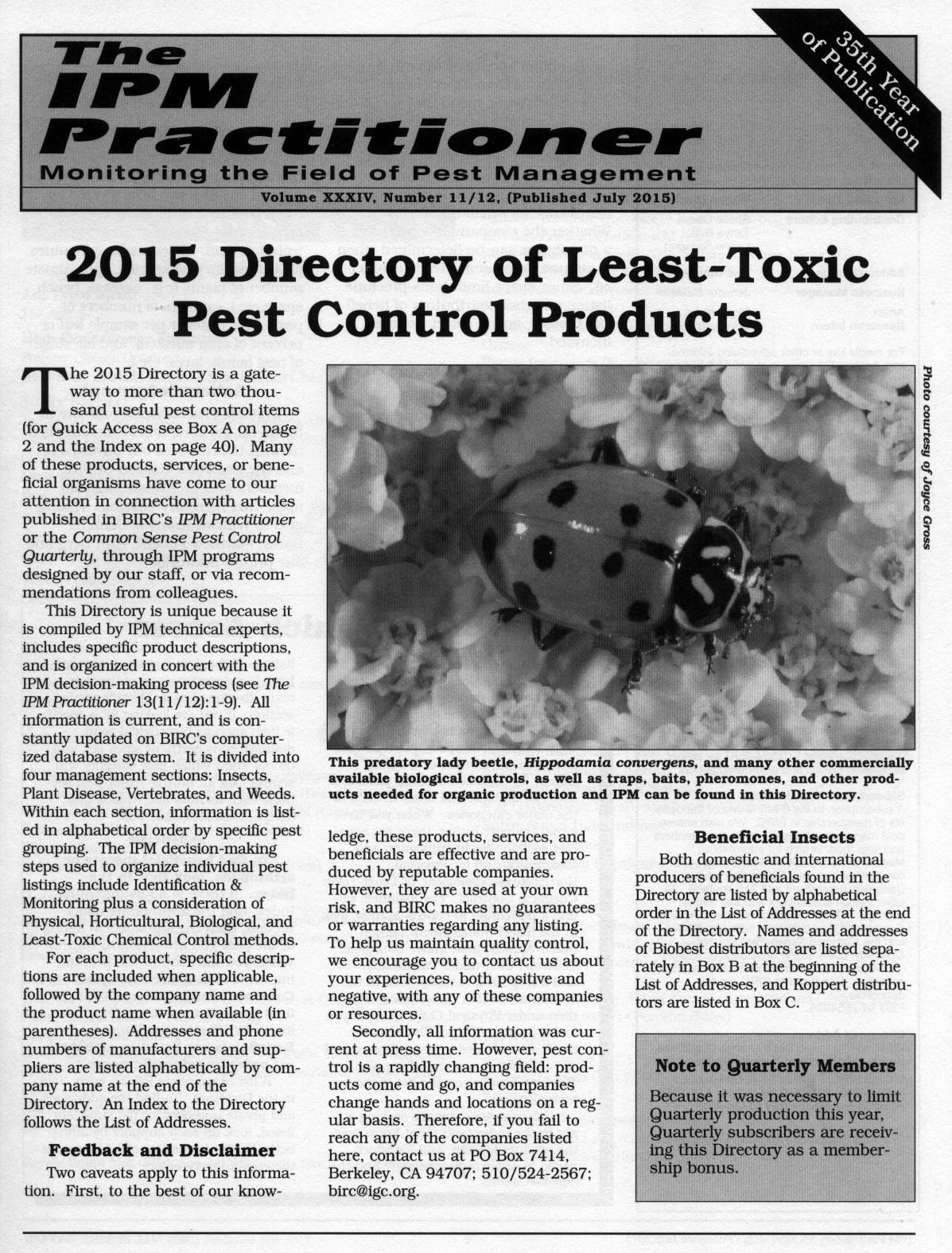
An online
version is available if you click here.
Those who want to buy a hard copy of this 48-page resource
can order it from the Bio-Integral Resource Center (BIRC),
PO Box 7414, Berkeley, CA 94707. Cost is $15 including mailing
and handling. California residents add 9% sales tax. A convenient
order form is available here.
Hard copies of the Directory are excellent assets for IPM
Training Programs and Conferences. Quantity discounts are
available until supplies run out. Call BIRC at 510-524-2567
or email us at birc@igc.org for a price quote.
Acknowledgement The 2015 Directory of Least-Toxic Pest Control
Products was supported, in part, through a grant from StopWaste.Org.
BIRC is extremely grateful to StopWaste.Org for its assistance
in producing the Directory.
Bees Attracted to Neonicotinoids
The lead article of our new publication reviews the latest
information on neonicotinoids and bees. The USDA has just
released a beekeeper survey showing that more than 40% of
U.S. commercial honey colonies were lost last year. Pesticides
are one of the problems, and bees are actually attracted
to neonicotinoids at concentrations seen in nectar and pollen.
Neonicotinoid concentrations in pollen and nectar from canola
seed treatments are large enough to reduce field densities
of wild bees. Seed treatments may not even be needed, as
no yield increases are generally seen in seed-treated soybeans.
As a precaution, the EPA has stopped approving new outdoor
uses of neonicotinoids.
In another article, we discuss the International Agency
for Research on Cancer (IARC) study showing glyphosate is
a probable human carcinogen. We briefly review glyphosate
toxicology. Exposure to glyphosate is widespread. Millions
of pounds are used each year, and there is evidence that
applicators absorb and excrete it. Amounts found on soybeans
in the marketplace can exceed the EPA standards for glyphosate
in drinking water.
Finally, we review cutting edge research on pheromone technology
from 16 presentations given at the Entomological Society
of America’s 2014 Conference. Plant volatiles are
being used to enhance pheromone attraction. Pheromone mass
trapping has become more practical. Pheromone dispersal
technology is being applied to attract pollinating bees.
Pheromone sources such as puffers reduce labor costs, and
structural pest control is benefitting from an Argentine
ant trail pheromone.
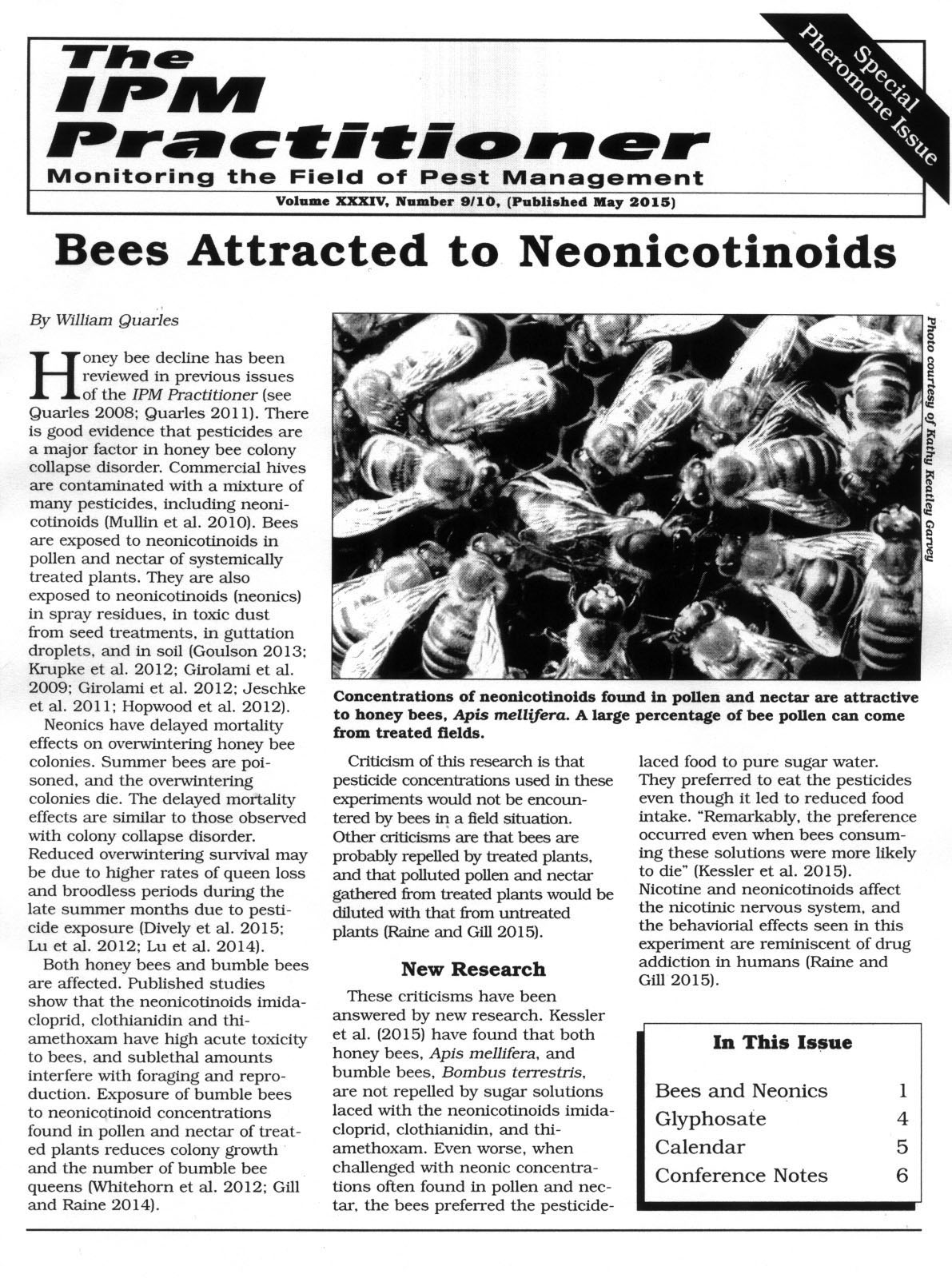
If you want to read this publication, please click here.
Hard copies are $8 each including postage. California residents
add 9% tax. Quantity discounts are available until supplies
run out. BIRC is a non-profit that depends on the support
of the public. If you would like to make a tax-deductible
donation to help us continue our work, become a BIRC member,
or order a publication, use the BIRC order form here.
Protecting Amphibians from Pesticides
Our latest publication reviews the connection between pesticides
and amphibian decline. In some cases, amphibians are killed
directly upon exposure. There are also sublethal effects
such as delayed metamorphosis, increased predation, reduced
size, reproductive problems, deformities, and depressed
immune systems that lead to destruction. We identify which
pesticides are causing the worst damage.
Amphibians are exposed through direct overspray, pesticide
drift, rainfall, and runoff into water bodies. About 83%
of urban streams and 57% of agricultural streams are contaminated
with enough pesticide to be hazardous to aquatic life. Windblown
pesticides from aerial applications are killing amphibians
in remote mountain areas.
We also provide solutions to the problem. Some pesticides
such as glyphosate, atrazine, endosulfan, chlorpyrifos,
and chlorthalonil should be used much less or restricted.
Glyphosate and atrazine together represent 30% of all conventional
pesticides used in the U.S.
We can also protect amphibians by using IPM methods in agriculture,
homes, gardens, and professional landscapes. A combination
of cultural methods, resistant plants, conservation biocontrol,
and reduced risk pesticides can be effective.
Buying organic food, replacing lawns with native plants,
creating backyard water gardens, helping with wetland restoration,
and using mechanical methods, mulches, and competitive plantings
for weed control can help protect amphibians from pesticides.
Backyard gardens with resources for amphibians, birds, butterflies,
bees and beneficial insects are aesthetically pleasing and
can help prevent the relentless slide of amphibians toward
extinction.
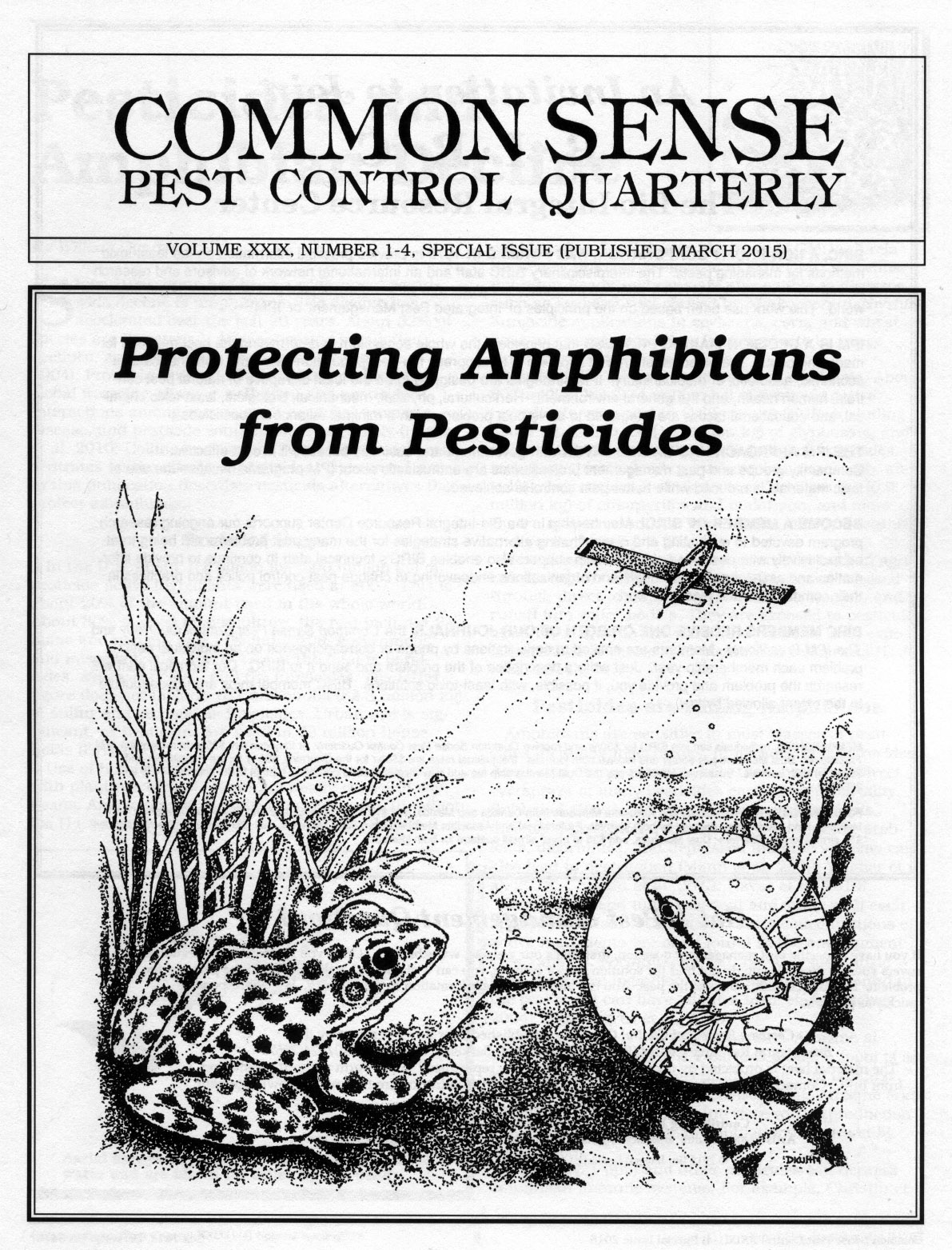
If
you want to read this publication, please click here.
Hard copies are $8 each including postage. California residents
add 9% tax. Quantity discounts are available until supplies
run out. BIRC is a non-profit that depends on the support
of the public. If you would like to make a tax-deductible
donation to help us continue our work, become a BIRC member,
or order a publication, use the BIRC order form here.
New IPM Methods for Bed Bugs
If you have bed bugs, do not panic. Our latest publication
reviews new IPM methods for bed bug control. Because bed
bugs are resistant to many pesticides, pesticide applications
alone are generally not effective. Pest management professionals
are using IPM methods such as prevention, monitoring, vacuuming,
mattress encasements, traps, repellents, heat and steam,
cold, fumigation and reduced risk pesticides.
Heat, carbon dioxide fumigation, and treatments with amphorous
silica such as diatomaceous earth or silica gel can be very
effective. New traps and pheromones are making detection
easier. Reduced risk pesticides such as neem and essential
oils can provide relief.
IPM methods reviewed in this publication can reduce pesticide
applications by 96%, and in some cases, bed bugs can be
controlled entirely by non-chemical methods.
Can Bed Bugs Carry Ebola?
The second article in this publication reviews the relationship
between bed bugs and pathogens. Bed bug bites can cause
extreme irritation, psychological problems, allergic reactions
and asthma. But bed bugs also can carry pathogens on, and
inside their bodies, and can excrete pathogens in their
feces.
Bed bug vector competence for human diseases has never been
proven, but mechanical transmission of Trypanosoma cruzi,
which causes Chagas disease, has been shown in the laboratory.
There are strong suspicions that hepatitis B can be transmitted
in this way.
Ebola is spread by touching infected humans and their belongings,
and the Ebola virus can persist in the environment from
14 to 50 days. Since bed bugs can pick up pathogens from
human skin and carry them on their bodies, they may be able
to passively carry Ebola in this way. Bed bugs have been
shown to ingest and excrete pathogens such as Q fever, caused
by Coxiella burnetii, and HIV. If other pathogens can be
carried in this way, they can probably carry Ebola. Whether
or not they can actually transmit the disease depends on
amount of virus needed to initiate human infection.
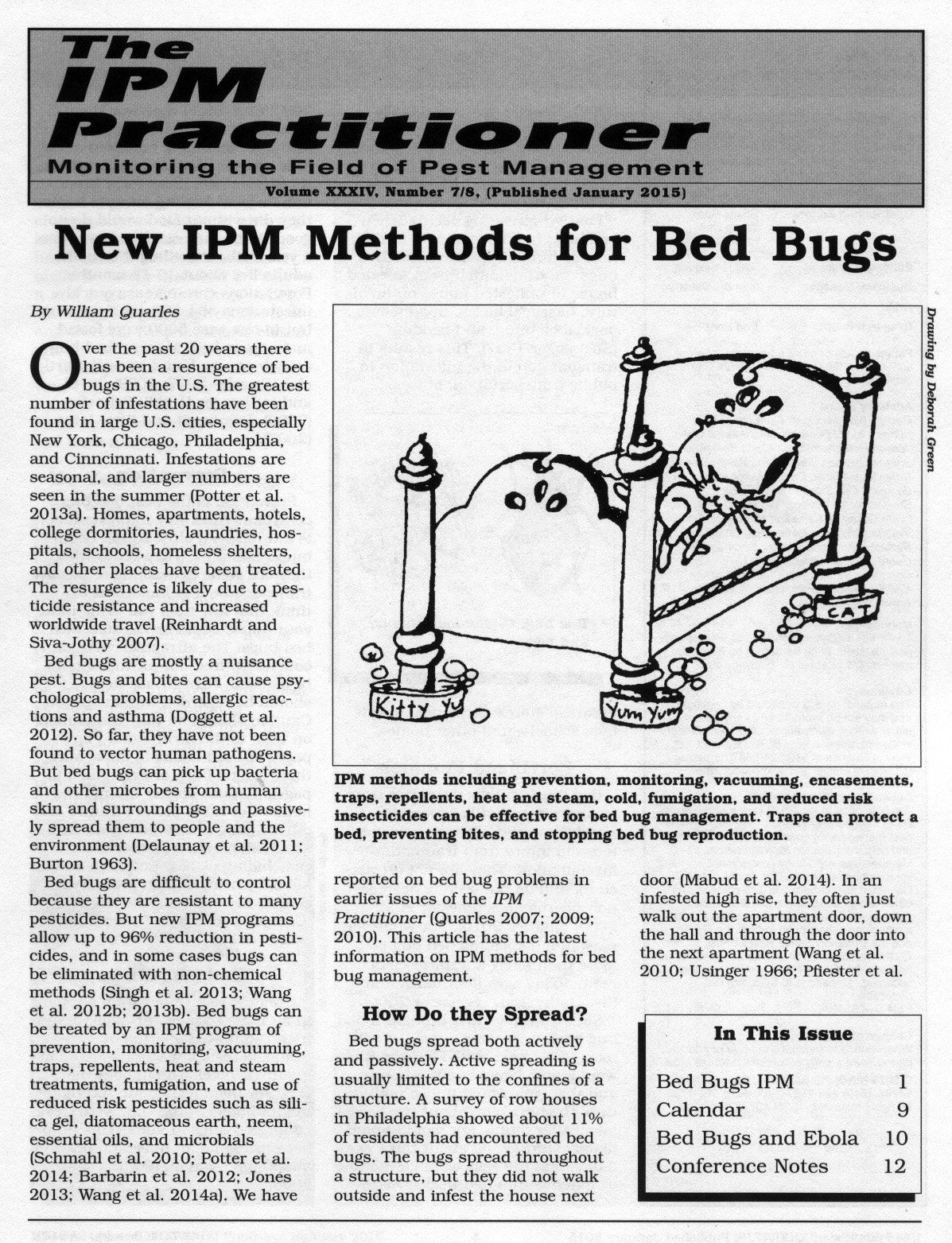
If you want to read this publication, please click here.
Hard copies are $8 each including postage. California residents
add 9% tax. Quantity discounts are available until supplies
run out. BIRC is a non-profit that depends on the support
of the public. If you would like to make a tax-deductible
donation to help us continue our work, become a BIRC member,
or order a publication, use the BIRC order form here.
What
Are You Eating? Labeling Genetically Engineered Food (GMOs)
Our latest publication reviews labeling of genetically engineered
food. These products are not labeled despite the fact that
90% of Americans support labeling. GMOs are labeled in Europe,
but the political process in the U.S. has been paralyzed
due to vigorous lobbying by major corporations.
GMOs should be labeled because they are novel foods, containing
genes and proteins not found in nature. Some GMOs contain
systemic pesticides, and the effects of longterm exposure
to these products have not been fully investigated. Short
term toxicity tests have given conflicting results, and
longterm tests in rodents are few, flawed and hard to interpret.
One by one comparison of known nutrients in substantial
equivalence tests cannot identify all possible sources of
toxicity. New allergens created by the transformation process
may escape detection.
A flood of new products is headed toward the market, including
fresh produce and engineered animals. Overwhelmed regulators
may make mistakes. Labeling is needed because knowledge
of genetics is incomplete, research is still active on recently
commercialized technology, and regulatory failures could
occur. Industry is lobbying for no regulation at all.
Some GMOs are associated with environmental disasters such
as destruction of monarch butterfly habitat and production
of superweeds. A pesticide treadmill of new crops resistant
to 2,4-D and other toxic herbicides will cause increased
environmental pollution and more concentrated herbicide
residues in food.
GMOs should be labeled because consumers are being deprived
of their right to make choices. The courts have ruled that
the way money is spent can be speech, and some legal scholars
believe that food choice is a form of protected speech.
GMOs should also be labeled because America is in the midst
of an epidemic of food related diseases. Those afflicted
with food allergies, asthma, clinical gastric upset, diabetes,
fatty liver and other diseases should have all the information
they need to make changes in their diet.
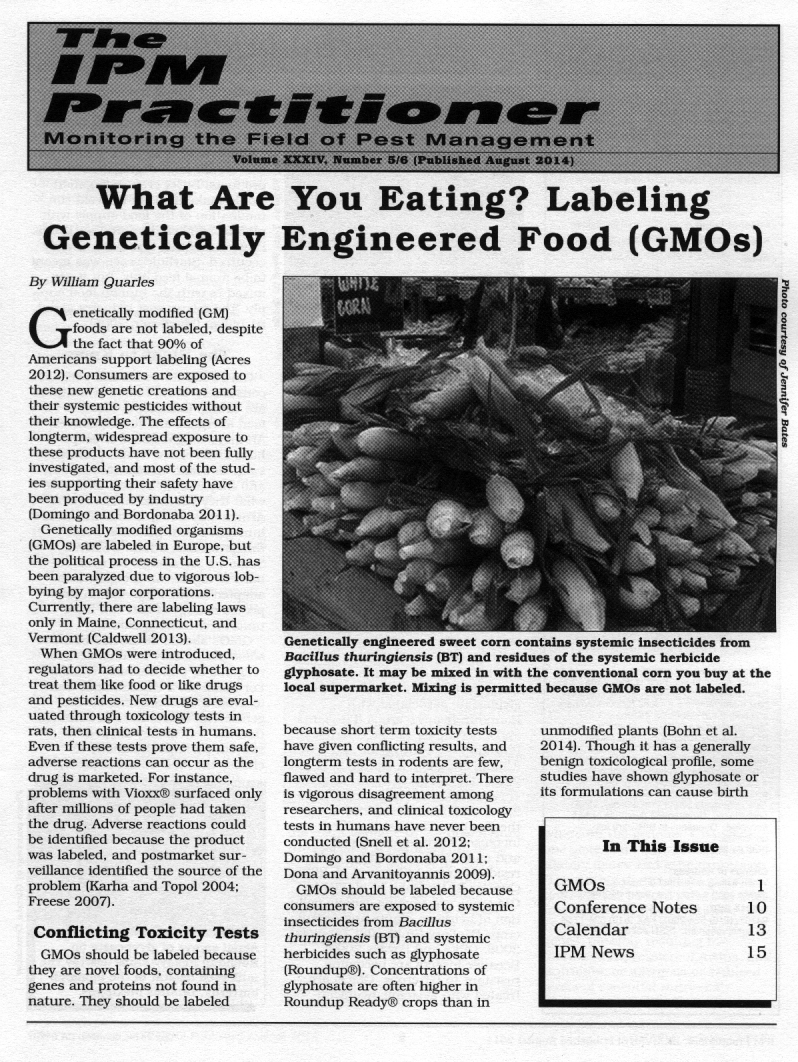
If you want to read this publication, please click here.
Hard copies are $8 each including postage. California residents
add 9% tax. Quantity discounts are available until supplies
run out. BIRC is a non-profit that depends on the support
of the public. If you would like to make a tax-deductible
donation to help us continue our work, become a BIRC member,
or order a publication, use the BIRC order form here.
IPM
for the Brown Marmorated Stink Bug
The invasive brown marmorated stink bug, Halyomorpha
halys, has spread to 41 states in the 13 years since
its introduction to the U.S. It is a threat to commercial
agriculture, landscape ornamentals, and backyard gardens.
It is also a structural pest, as large populations invade
houses, trying to overwinter.
The pest is exploding in the U.S. due to lack of specific
natural enemies, prolific reproduction, wide host range,
and effective overwintering strategies. It is cold tolerant
and is reaping the benefits of global warming.
Growers have responded to stink bug proliferation through
increased pesticide applications that are disrupting IPM
programs, causing outbursts of secondary pests such as mites,
aphids, and scales.
This article reviews monitoring, pheromone trapping, barriers,
repellents, biological controls, biopesticides and other
IPM methods that will manage H. halys populations, while
sparing beneficial insects and bees.
Also included in this Special Pheromone Issue is
a Pheromone Report from the ESA 2013 Meeting in Austin,
TX and the latest IPM News.
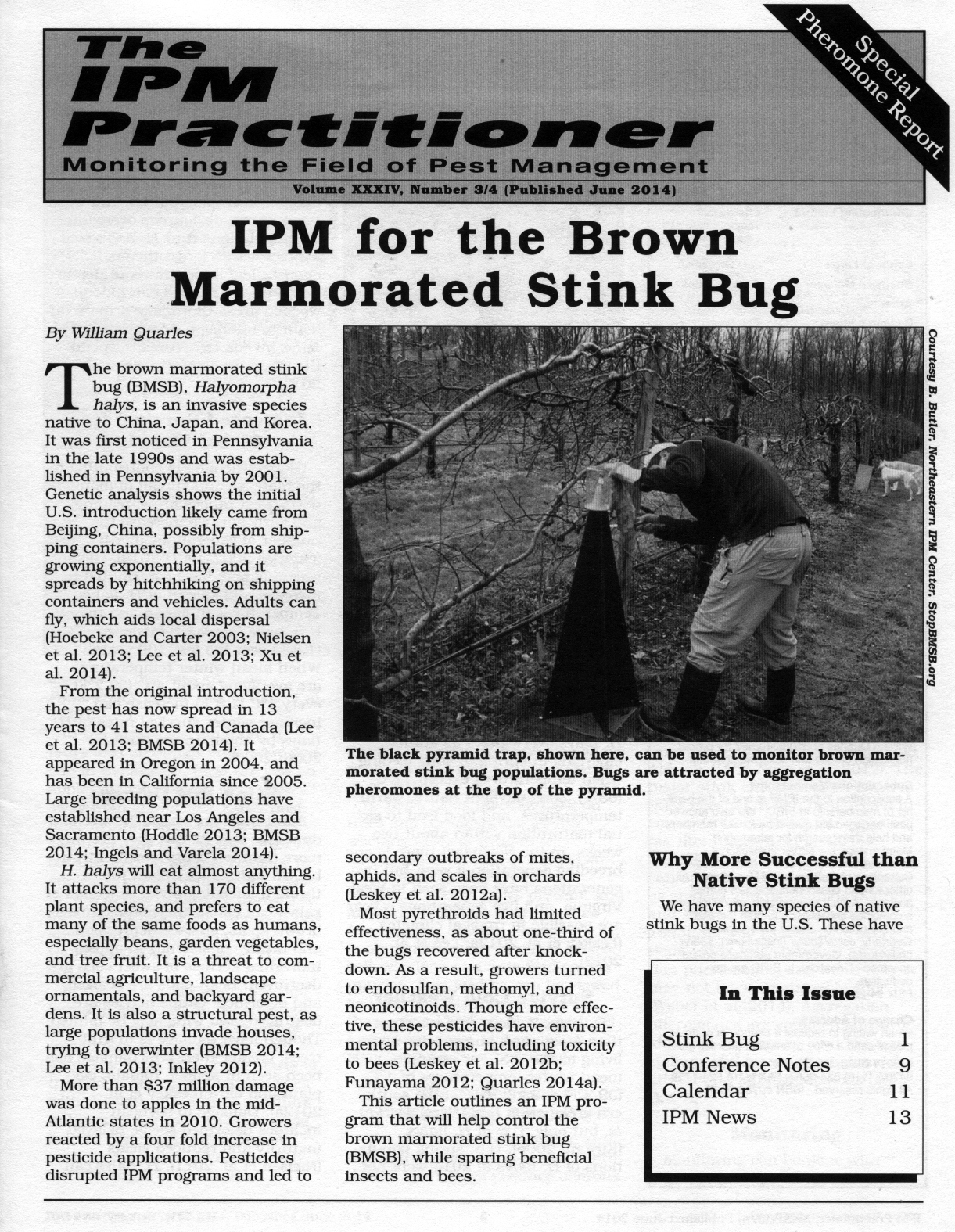
If
you want to read this publication, please click here.
Hard copies are $8 each including postage. California residents
add 9% tax. Quantity discounts are available until supplies
run out. BIRC is a non-profit that depends on the support
of the public. If you would like to make a tax-deductible
donation to help us continue our work, become a BIRC member,
or order a publication, use the BIRC order form here.
Protecting
Bees, Birds, and Beneficial Insects from Neonicotinoids
About one-third of the managed honey bee colonies in the
U.S. are dying each year. Part of the problem is exposure
to systemic insecticides called neonicotinoids. Neonics
are applied in field crops, orchards, parks, landscapes,
backyard gardens, on ornamentals, lawns, pets, and in structural
pest control. Some of them are extremely persistent, providing
a large window of exposure. At least 45% of U.S. cropland
is treated.
This new issue of Common Sense Pest Control Quarterly reviews
effects of neonicotinoids on bees, birds, and beneficial
insects. Bees and beneficials are exposed to toxic residues
from sprays, and to poisonous nectar and pollen from systemic
treatments. Predatory insects are killed through secondary
poisoning from consuming pest insects that contain neonics.
The largest impact on birds is through neonic seed treatments.
One treated seed is enough to kill some birds. There are
also sublethal effects on bird reproduction.
This issue also suggests alternatives to neonicotinoid applications.
In almost every case, cultural and ecological changes can
be combined with IPM methods, biological control, biopesticides,
and other low impact pesticides to correct the pest problem.
Avoiding pesticides, choosing native plants, breaking up
monocultures, hedgerow plantings, growing organic gardens,
and buying organic food are some of the choices that we
can make to protect bees, birds, and beneficial insects
from neonicotinoids. Specific plantings are recommended
to encourage bees, birds, butterflies and other pollinators.
IPM methods are suggested to manage pest problems.
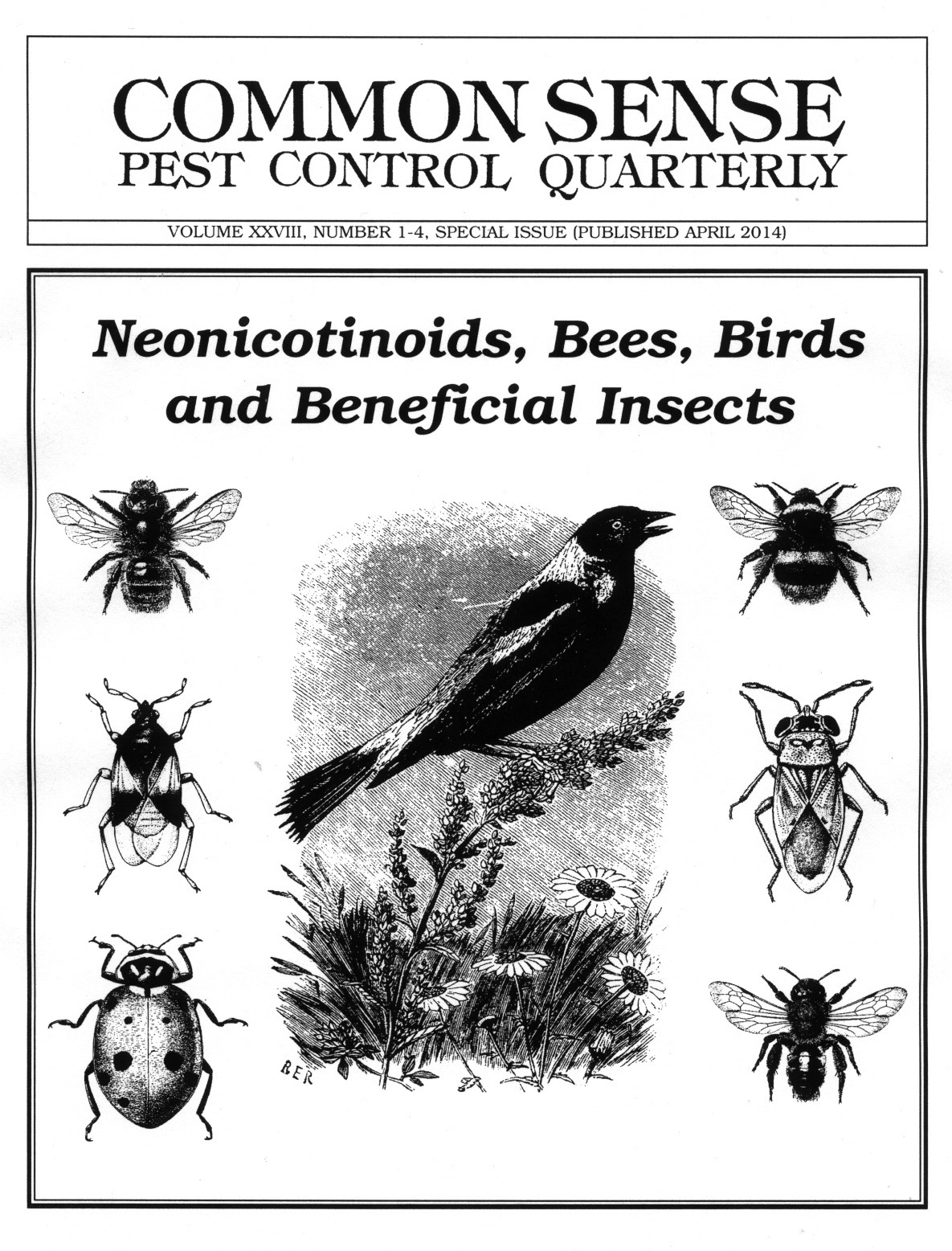
If you want to read this publication, please click here.
Hard copies are $8 each including postage. California residents
add 9% tax. Quantity discounts are available until supplies
run out. BIRC is a non-profit that depends on the support
of the public. If you would like to make a tax-deductible
donation to help us continue our work, become a BIRC member,
or order a publication, use the BIRC order form here.
IPM
for Asian Citrus Psyllid and Huanglongbing Disease
Citrus trees in the U.S., Brazil, Mexico and elsewhere are
being killed by an aphid-like insect called the Asian citrus
psyllid, Diaphorina citri. The insect feeds on the phloem
of Citrus trees. In the U.S., psyllids transmit the bacterium
Candidatus Liberibacter asiaticus, causing a disease called
citrus greening or huanglongbing (yellow dragon).
The first signs of infection are yellow shoots and leaves
with asymmetric yellow blotches. As the disease develops,
small, green, misshapen fruit with bitter juice drop prematurely,
dramatically reducing yield. After about 3-5 years, infected
trees die, and currently there is no cure.
Both the disease and the psyllid have been found in California,
Texas, and Florida. About 18% of the 60 million sweet orange
trees, Citrus sinensis, in Florida have been infected. The
disease has caused the death of about 40 million citrus
trees worldwide.
Huanglongbing is leading to grower panic and the overuse
of pesticides in a desperate attempt to stop the disease.
As many as 6-15 foliar and 1 to 2 systemic pesticides are
applied each year from five different chemical classes.
This barrage is leading to pesticide resistance and damage
to bees and beneficial insects.
This article reviews IPM methods that can manage the psyllid
and the disease without destroying bees, beneficial insects
and other elements of the environment.
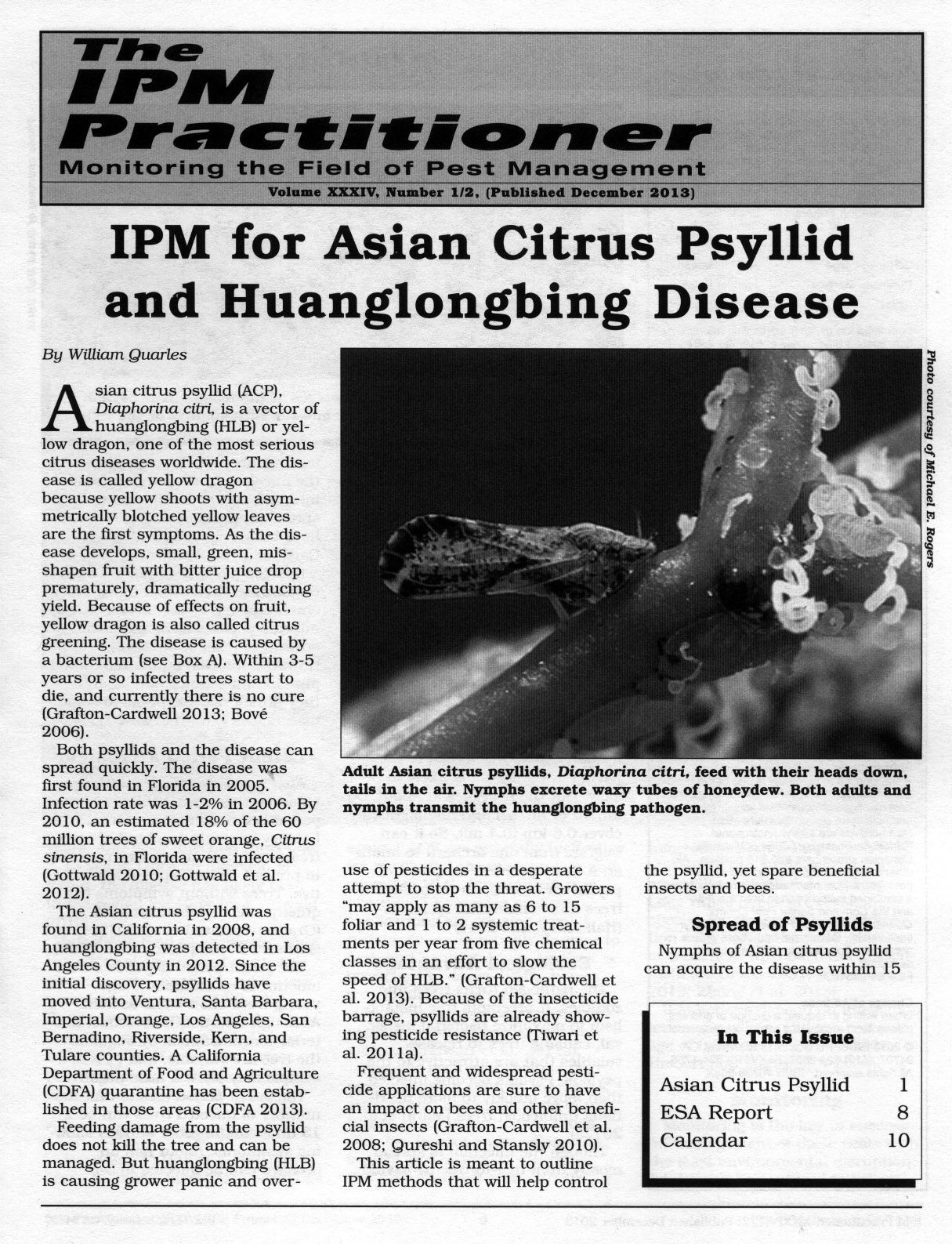
If you
want to read this publication, please click here.
Hard copies are $8 each including postage. California residents
add 9% tax. Quantity discounts are available until supplies
run out. BIRC is a non-profit that depends on the support
of the public. If you would like to make a tax-deductible
donation to help us continue our work, become a BIRC member,
or order a publication, use the BIRC order form here.
Baits
or Barriers? Field Efficacy of Subterranean Termite Treatments
If you have subterranean termites and cannot decide whether
to use chemical barriers or termite baits, this classic
publication can help you with the problem. Once you decide
between bait or barrier, the article can help you choose
the most effective product and minimize effects on the environment.
The publication draws on field tests conducted by the USDA,
termite research specialists, and the experience of pest
control operators to identify the most effective and least
toxic treatments for subterranean termites.
The publication also has new information about the biology
of termites. New technology has revealed the genetic structure
of termite colonies. Colonies containing thousands of termites
may be produced by one queen. An average property may have
6 genetically independent termite colonies capable of attacking
your home. When your home is attacked, it is usually only
one of these colonies.
The efficacy of termite baits is sometimes questioned. Although
effects are complex, published studies show an expected
efficacy of 85-100%.
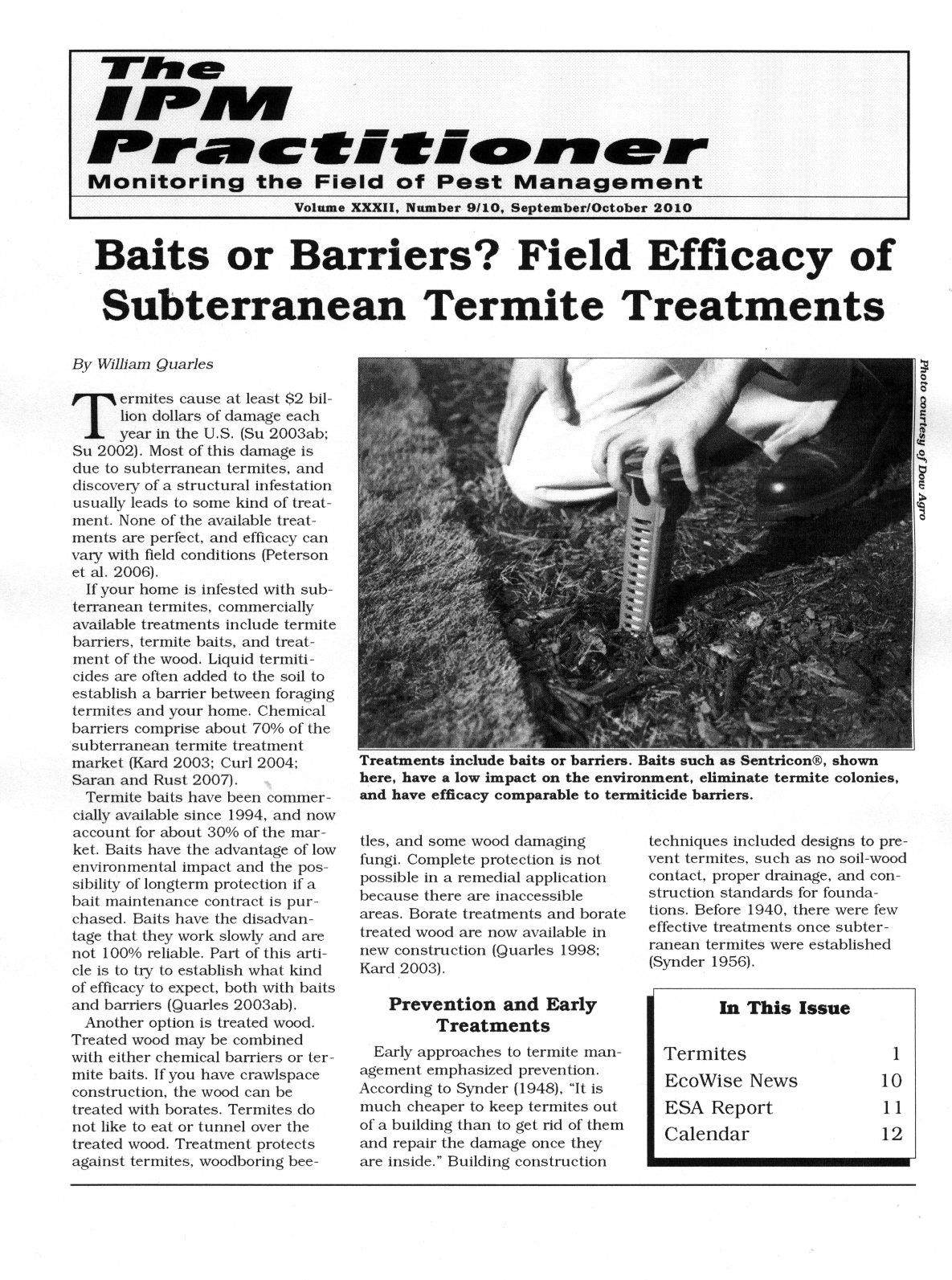
If
you would like to read this new publication, click here.
Hard copies are $8 each including postage. California residents
add 8.75% tax? Quantity discounts are available until supplies
run out.
BIRC is a non-profit that depends on the support of the
public. If you would like to make a tax-deductible donation
to help us continue our work, become a BIRC member, or order
a publication, use the BIRC order form here.
Bats,
Pesticides and White Nose Syndrome
Millions of bats in the U.S. have been killed by a mysterious
new disease. Death is associated with a fungus, Geomyces
destructans, that attacks their skin. White fungal lesions
appear on their bodies and on their noses, which has led
to the name "white nose syndrome." G. destructans
has attacked at least nine different bat species, and according
to biologists at the U.S. Fish and Wildlife Service, more
than 5.5 million bats in 20 states have died since 2006.
The same fungus is present in Europe, but mass die-off of
bats is not happening there. The immune system of U.S. bats
cannot deal with the disease. This article reviews the possible
causes of immune suppression in bats. Pesticide exposure
is one possible cause. Due to their long lifetime and voracious
appetites, bats are vulnerable to accumulation of pesticides
and environmental contaminants. One possible solution to
white nose syndrome is conversion to IPM methods or increased
organic production, especially near areas of bat hibernation.
Bats eat tons of pest insects each year. Loss of bat biological
control worth an estimated $22 billion annually could mean
increased costs for crop production and increased use of
pesticides. Considerable environmental damage from pesticides
is already occurring. Overuse of glyphosate is leading to
habitat destruction for wildlife. Pests are growing resistant
to genetically engineered crops, and application of neonicotinoid
seed treatments are contributing to honey bee death and
decline. Mass die-off of bats could make honey bee problems
worse, due to increased pesticide applications.
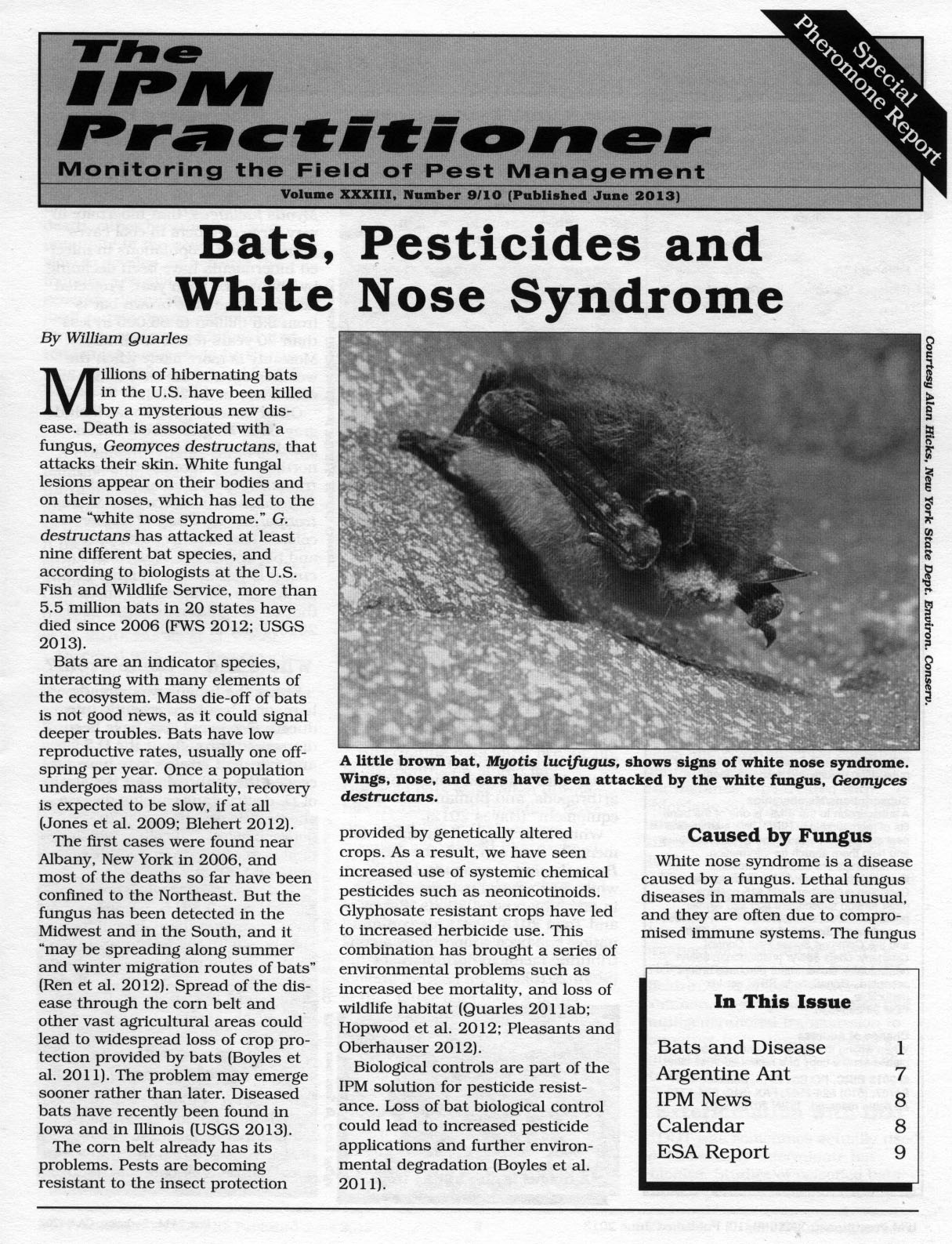
If you would like to read this publication, click here.
Hard copies are $8 each including postage. California residents
add 9% tax. Quantity discounts are available until supplies
run out. If you would like to order the publication, click
here.
New
Biopesticides for IPM and Organic Production.
March 2013: This IPM Practitioner publication
reviews the latest biopesticide products. Biopesticides
are either living organisms or have their origins in living
organisms. They are often target specific, benign to beneficial
insects, do not pose air or water quality problems, and
risks to human health are low. Insects are not resistant
to them, and some formulations are certified for organic
production. The publication includes a list of EPA registered
products and suppliers.
Biopesticides include herbicides, fungicides, insecticides
and nematicides. A new bioinsecticide called Grandevo™
should be useful in management of the destructive Asian
citrus psyllid, Diaphorina citri. Another bioinsecticide
called MET52™ has potential as a non-chemical treatment
for tick control. This product should be good news in areas
overrun by Lyme disease.
Phaseout of the soil fumigant methyl bromide has led to
registration of toxic and carcinogenic materials such as
1,3-dichloropropene for nematode control. New biopesticides
such as Econem™, Melocon™, and DiTera™
are now available that provide a non-chemical alternative
for nematodes.
Biofungicides such as Rootshield™, Mycostop™,
and Soilgard™ provide non-chemical alternatives for
soilborne pathogens. Products such as Regalia™, Serenade™,
and Sonata™ provide treatment for plant diseases.
Regalia and many of the other products are certified for
organic production.
New bioherbicides have been developed that can help control
weeds without the environmental pollution seen with some
chemical herbicides. Some of these are commercially available,
others are in the last stages of EPA and California registration.
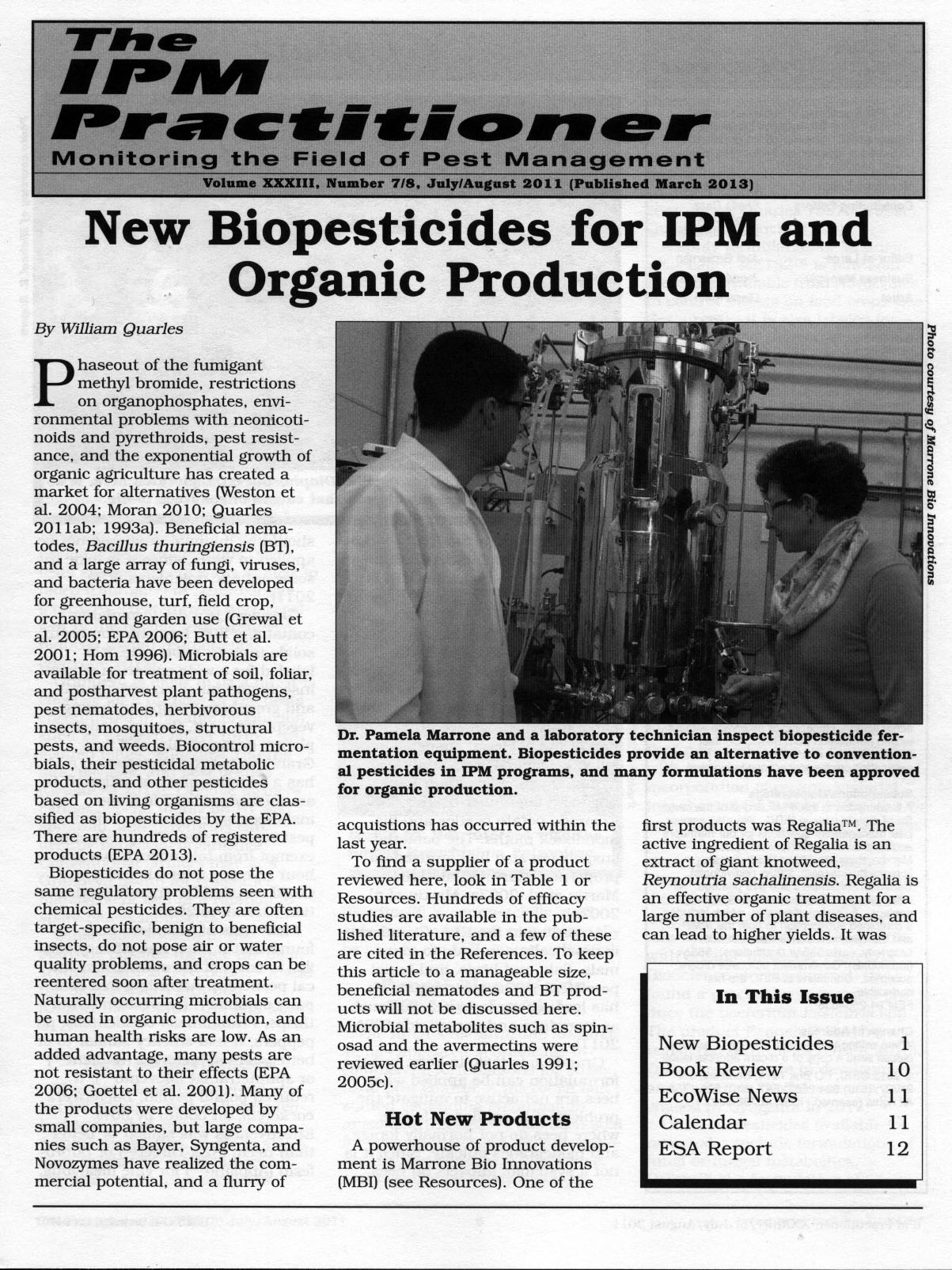
If you would like to read this publication, click here.
Hard copies are $8 each including postage. California residents
add 9% tax. Quantity discounts are available until supplies
run out. If you would like to order the publication, click
here.
Protecting
Raptors from Rodenticides, a new publication from
BIRC
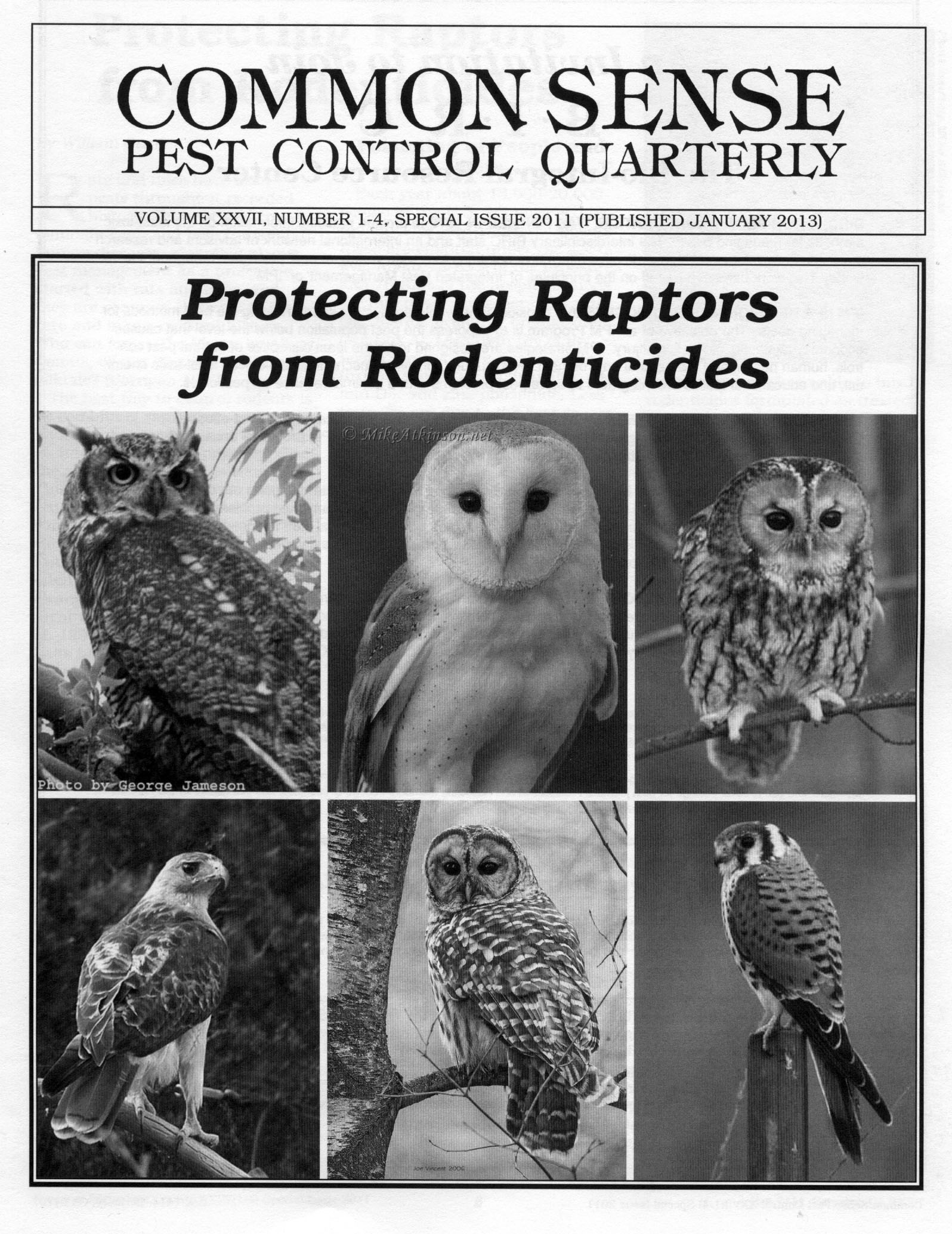
January 2013: About 13,000 to 20,000 people
each year are poisoned by rodenticides, and most of these
are children. About 80% of the hospitalizations are due
to second generation anticoagulants, mostly brodifacoum.
Of the 95,000 pets poisoned each year, about 74% is due
to brodifacoum. This type of rat poison is also causing
widespread poisoning of wildlife, including raptors.
Brodifacoum is a longlasting poison, and rats can accumulate
30 to 40 times a lethal dose before they die. Raptors that
eat these rats die of secondary poisoning. The problem is
widespread, and may kill 10-20% of raptor populations in
areas where the baits are used. Sublethal effects include
bleeding and disorientation leading to accidents. Poisoned
raptors are also more susceptible to disease.
BIRC’s new publication reviews the problem and proposes
effective, practical alternatives that will provide effective
rat management without killing raptors.
If you would like to read this publication, click here.
Hard copies are $8 each including postage. California residents
add 9% tax. Quantity discounts are available until supplies
run out. If you would like to order the publication, click
here.

August 2012: BIRC’s latest publication reviews
the problems resulting from the extensive use of genetically
engineered (GE) crops and systemic pesticides. Production
of GE crops (Roundup Ready™) resistant to the herbicide
glyphosate has resulted in a number of environmental problems,
including an 81% reduction of Midwest monarch butterfly
populations.
Excessive glyphosate applications may be impacting amphibian
populations and increasing populations of soil pathogens.
Soil pathogens are making systemic seed treatments with
fungicides necessary.
Extensive reliance on GE crops with systemic insecticides
from Bacillus thuringiensis (BT) is leading to insect resistance.
The resulting seed treatments with systemic neonicotinoid
insecticides are causing deaths of honey bees.
Dependence on glyphosate for weed management in GE crops
has led to creation of superweeds. The agribusiness solution
is a repeat of the pesticide treadmill—crops engineered
for resistance to multiple herbicides. Planting of these
new crops will at least triple the amount of 2,4-D and other
controversial herbicides being used in agriculture.
A better solution is a return to IPM principles that allow
both sustainable crop production and environmental protection.
If you would like to read this publication, click here.
Hard copies are $8 each including postage. California residents
add 9% tax. Quantity discounts are available until supplies
run out. If you would like to order the publication, click
here.
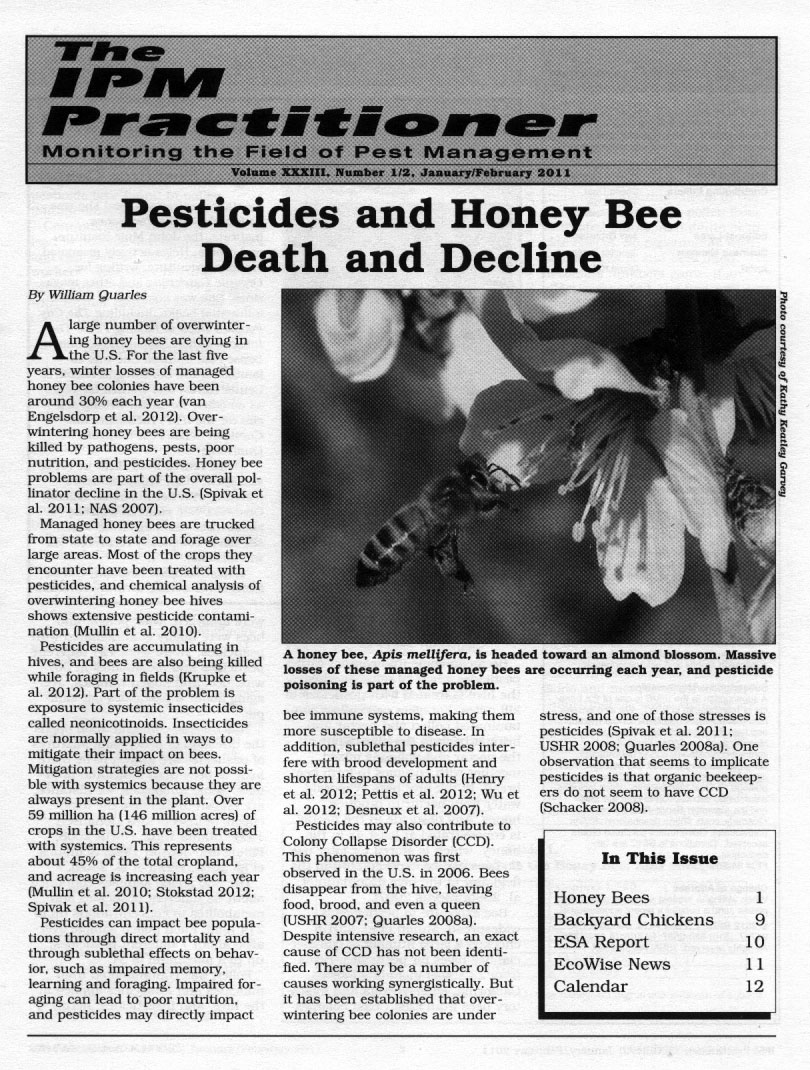
June 2012: BIRC’s latest publication reviews
honey bee death and decline due to extensive use of pesticides.
Chemical analysis of hives in 23 states show bees, pollen,
and wax combs are extensively contaminated with pesticides.
Contributing to the problem is the use of systemics in field
crops, especially corn. Use of systemics means that pesticides
are always present in the plant and mitigation strategies
are impossible. About 45% of U.S. cropland is treated with
systemics and use is increasing each year. In many cases,
systemics are not needed because IPM alternatives are available
that manage pests without killing bees.
This issue also includes an update on urban farming, the
EcoWise IPM Certification Program for pest control professionals,
and the latest information on bed bug pheromones and traps.
If you
would like to read this new publication, click here.
Hard copies are $8 each including postage. California residents
add 9% tax. Quantity discounts are available until supplies
run out. If you would like to order the publication, click
here.
